Step 9: How to Digitally Sign
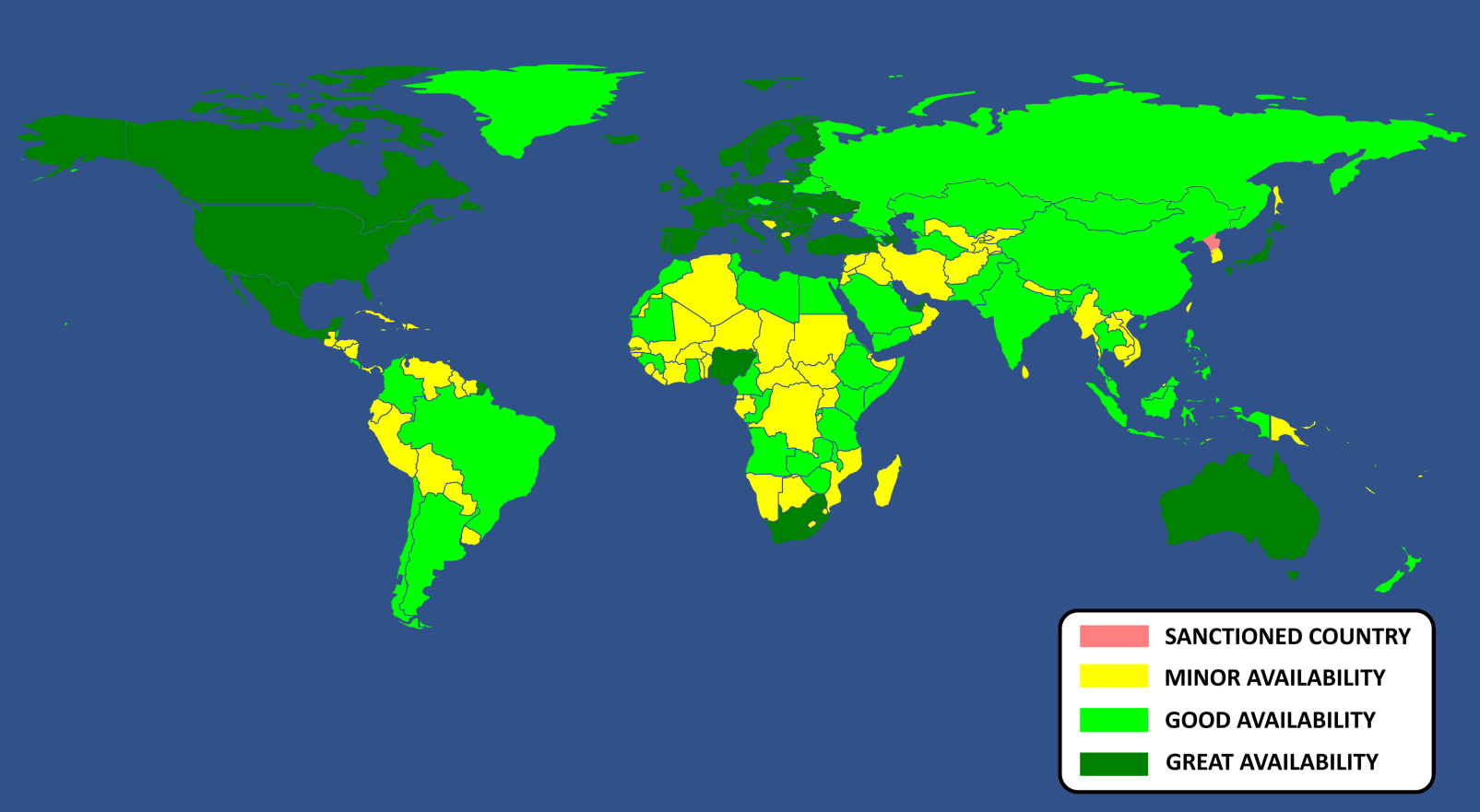
Qualified Electronic Signatures (QES) are a type of electronic signature that meets specific standards set by the European Union. QES are designed to have the equivalent legal effect of a handwritten signature, making them suitable for high-trust applications, such as signing contracts or official documents.
How to use the "Dokobit.com" Platform
Dokobit is our partner signature platform that allows us to streamline digital signing for you.
We use it in order to facilitate electronic signing.
How to sign documents using ElectronicID
2.0. There are two ways to start the signing process of a document when using ElectronicID video-based identification.
Open a Dokobit email invitation that you received and press "Review and sign".

2.1. Once you are redirected to the document signing page, in the first drop-down menu, select the issuing country of your ID, and in the second one, choose the Electronic ID signing method.
Note:This signing method will not be available to you if your document was issued by a country that is not listed in the drop-down menu.
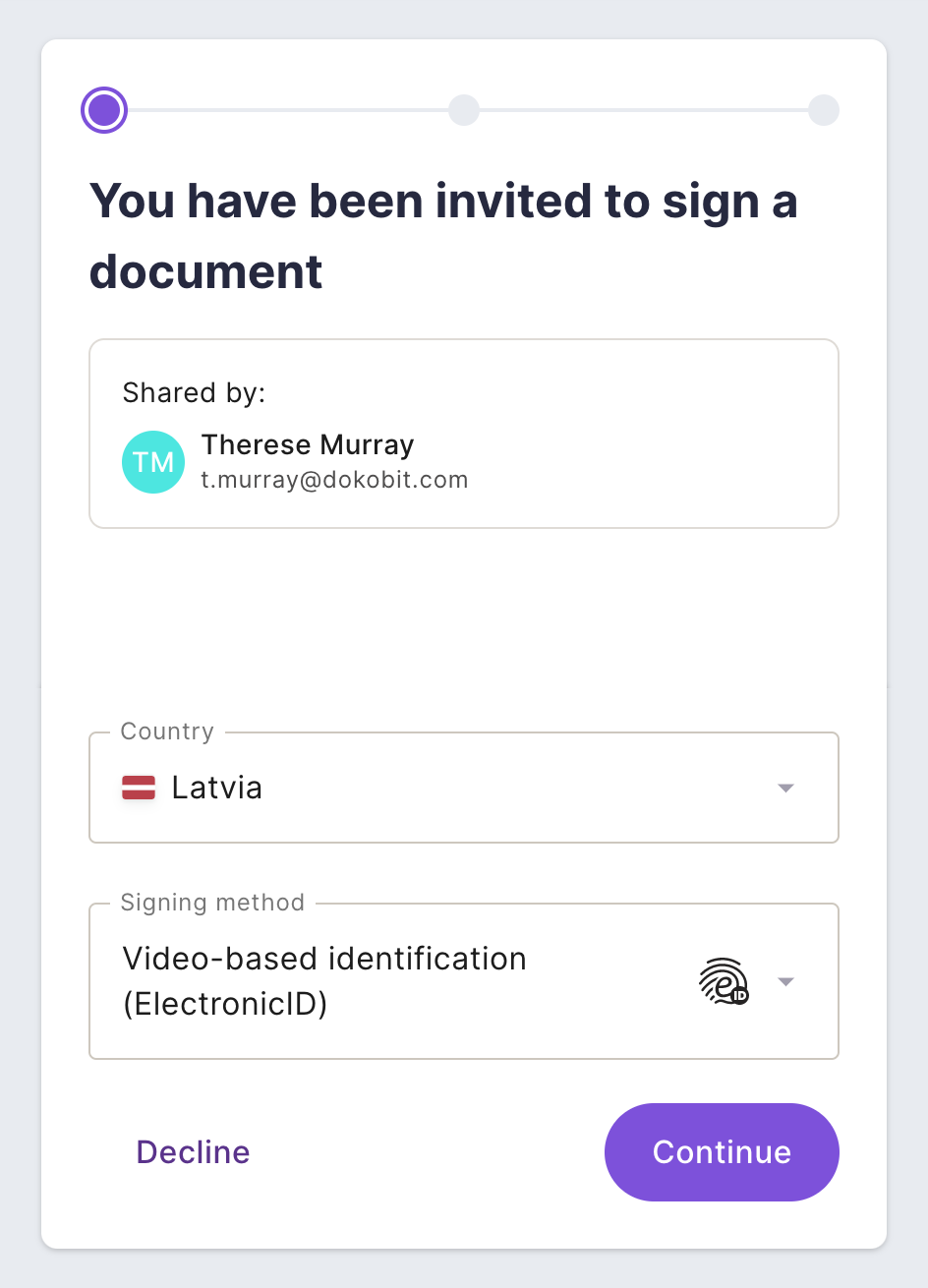
2.2. Get familiar with the requirements to make sure that you'll be able to successfully sign the document, and then press "Continue".
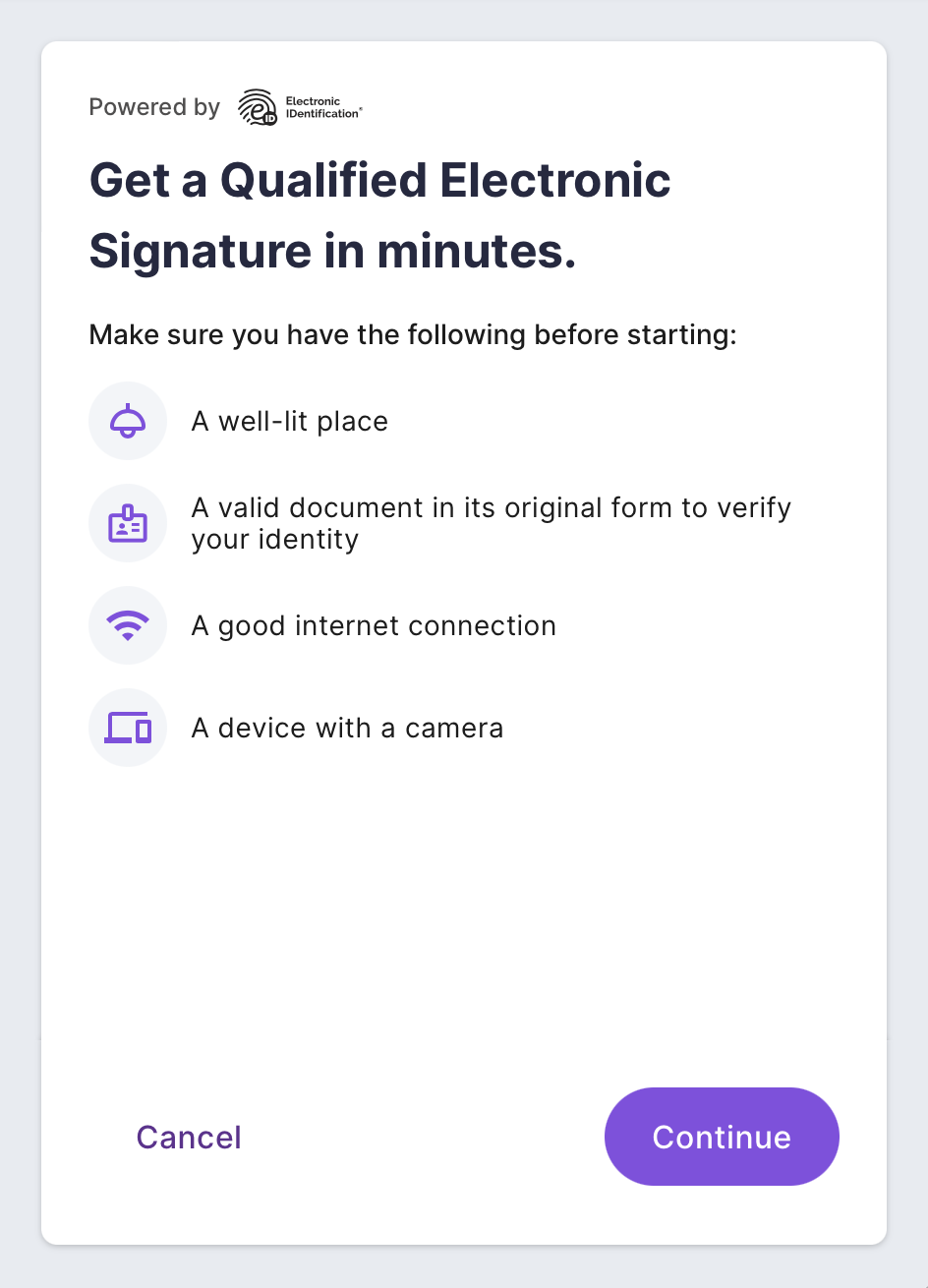
2.3. Accept the terms by marking both of the checkboxes and then press "Continue".
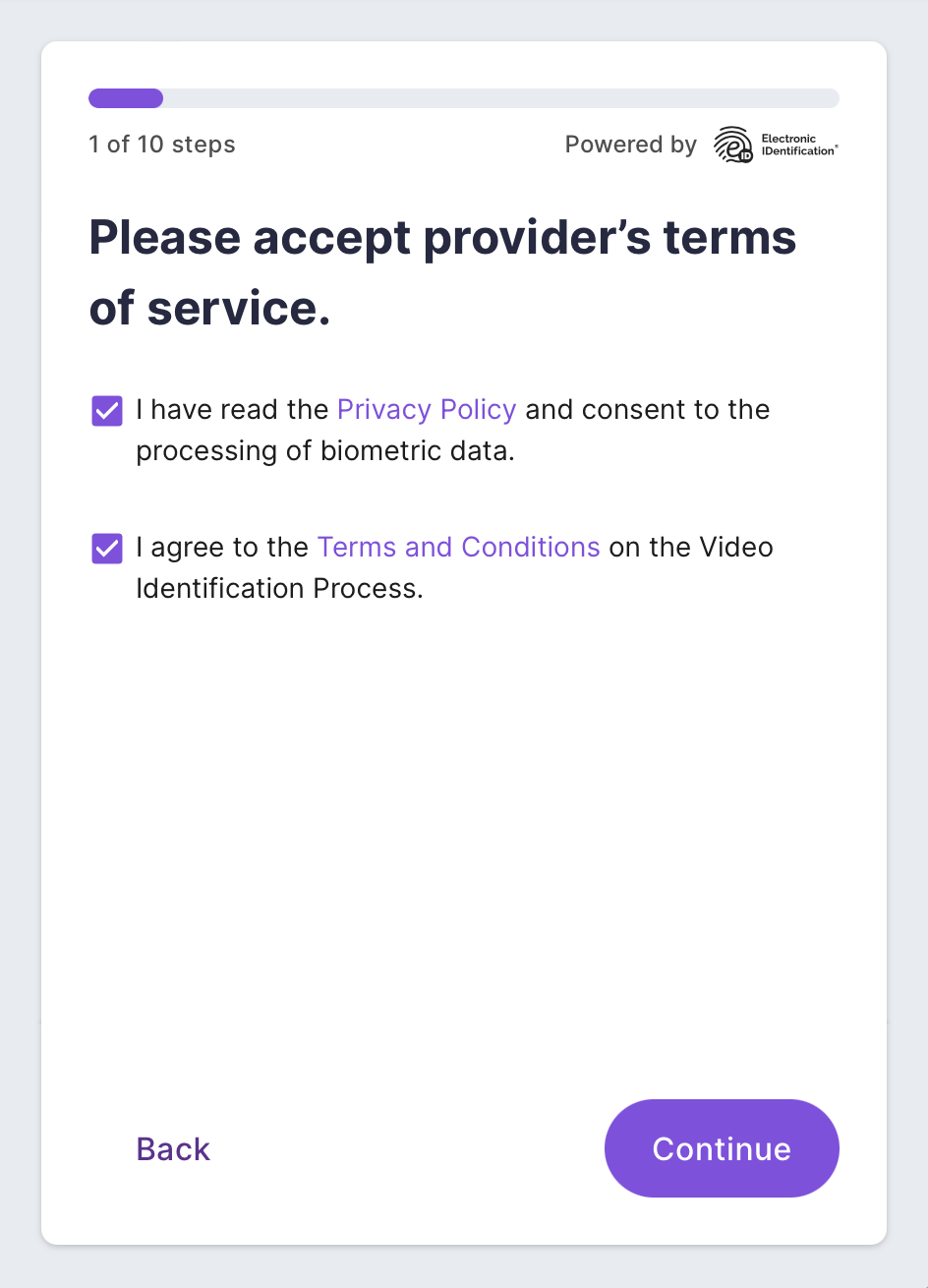
2.4. Once again, choose the issuing country of your ID as well as the type of document you plan to use, and then press "Start".
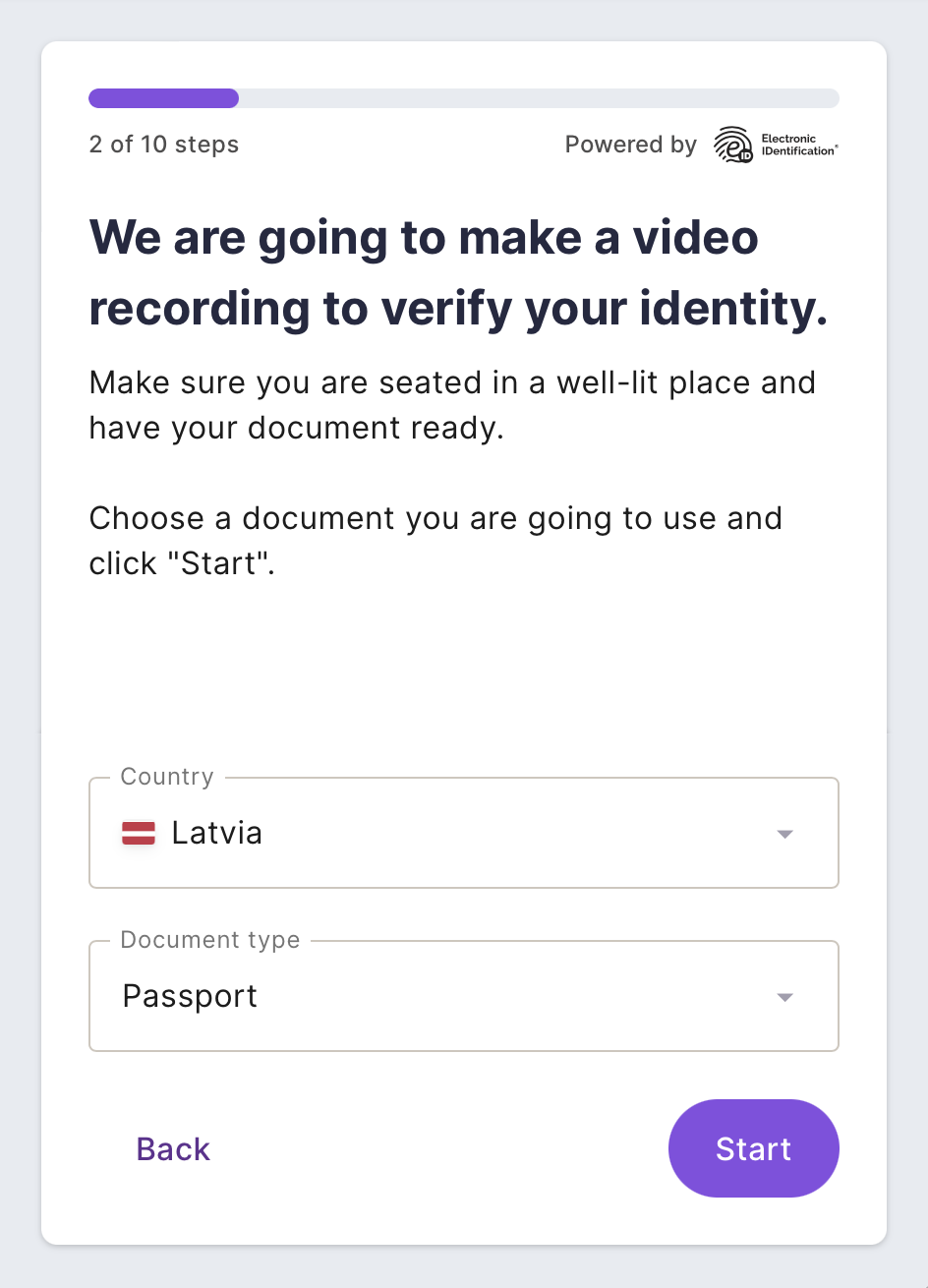
2.5. Your web browser will request access to your microphone and camera. Click "Allow".
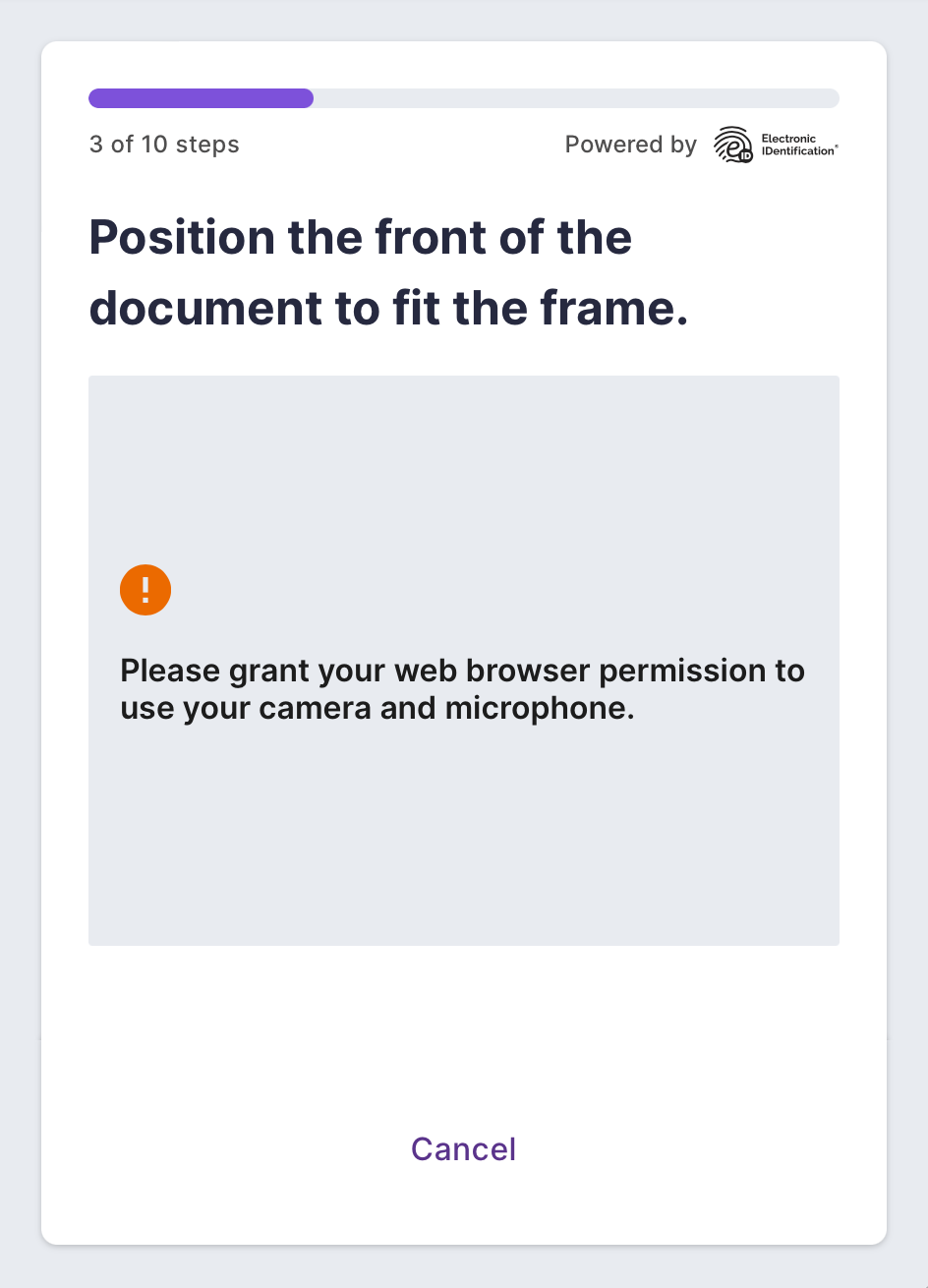
Note: Here's an example of the "block or allow" pop-up window that Google Chrome displays when requesting your permission:

2.6. The camera on your device will turn on and prompt you to position the document within the frame. Follow the on-screen instructions to ensure the document is scanned correctly.
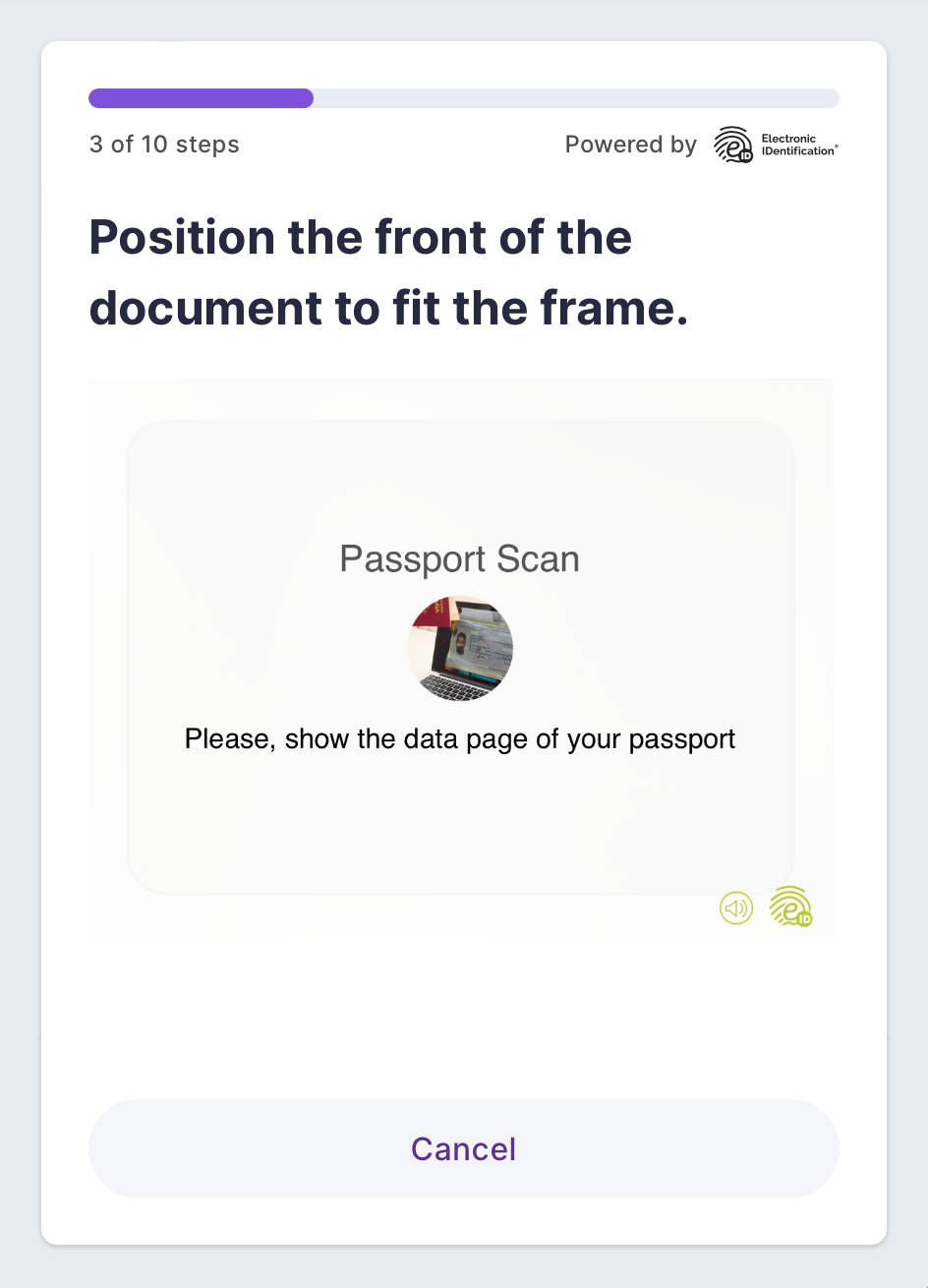
2.7. Once your document has been accepted, follow the prompts for capturing your face to ensure a successful identity verification process.
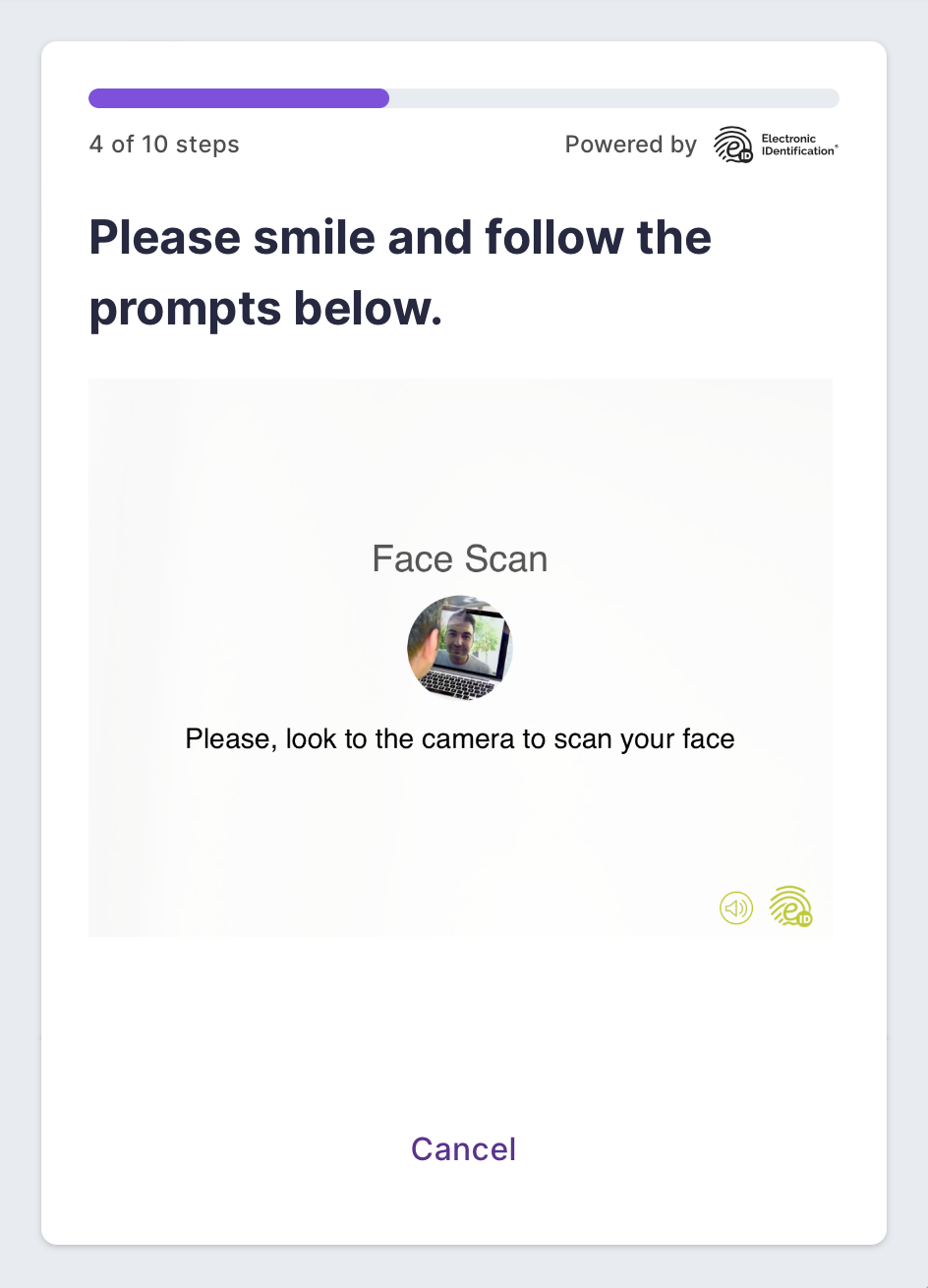
2.8. Once the recording is completed, enter your phone number to receive a verification code and press "Continue".
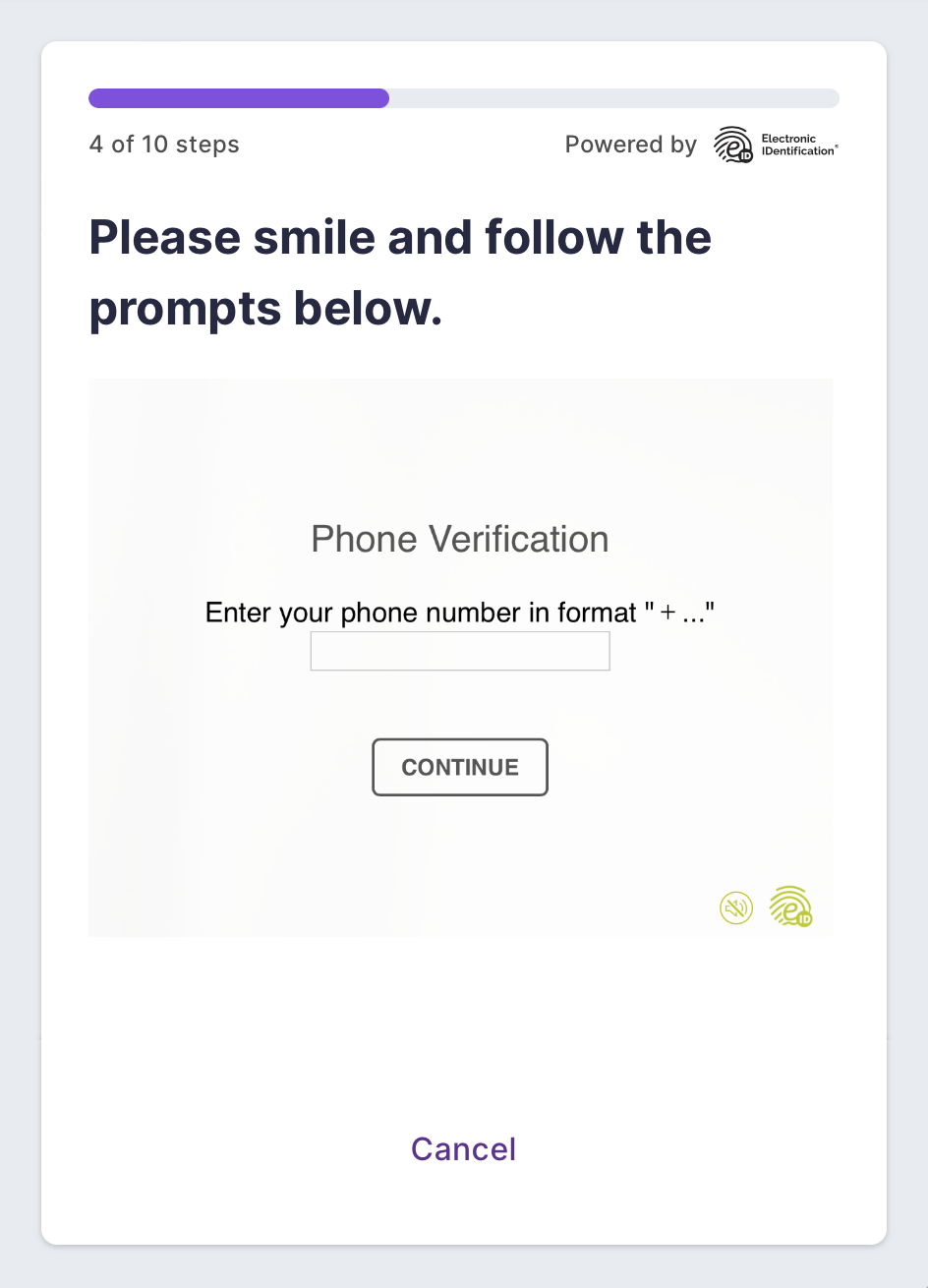
2.9. Enter the code which you received on your mobile device and press "Continue".
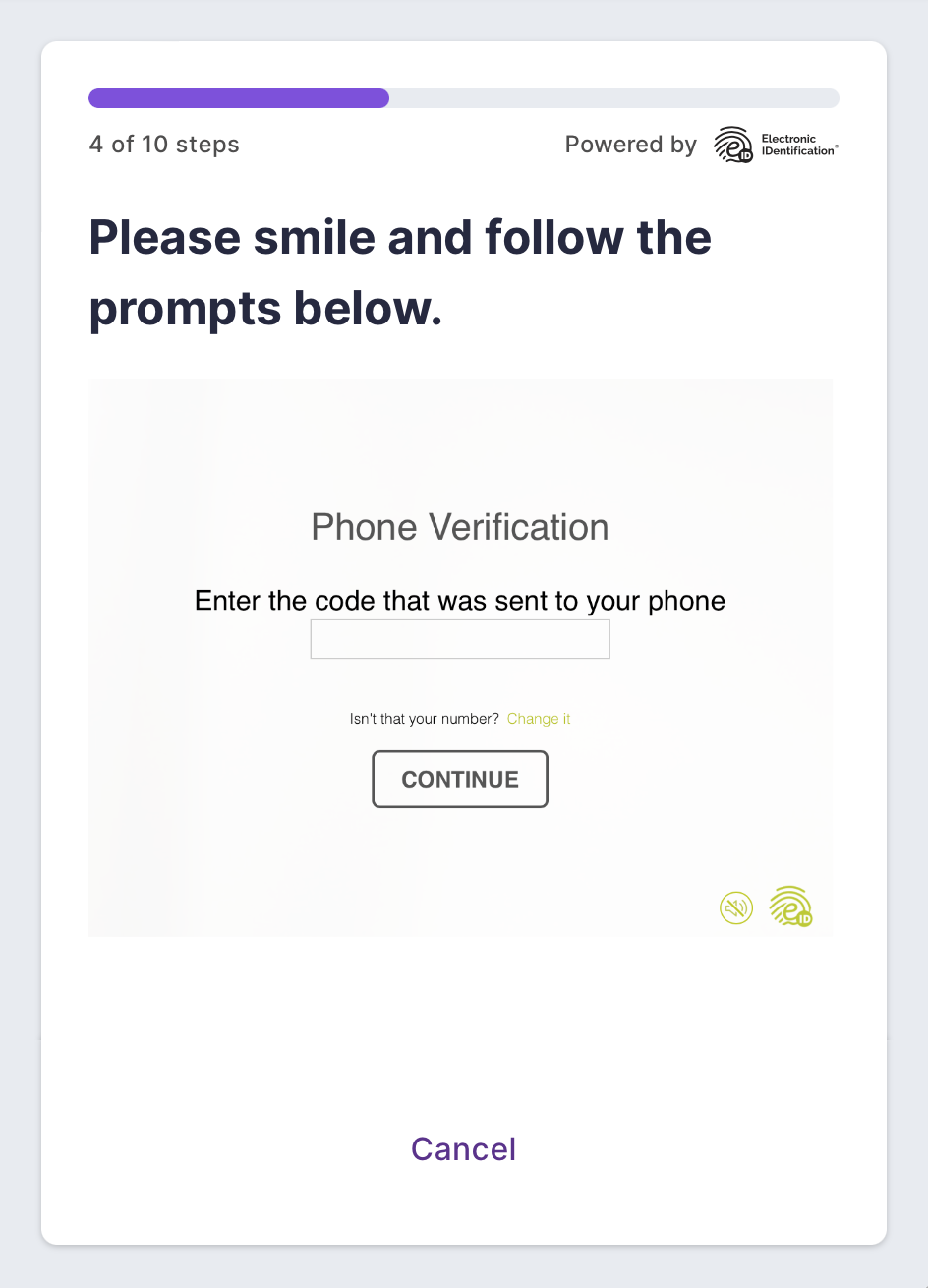
2.10. Please wait for your identity to be verified.
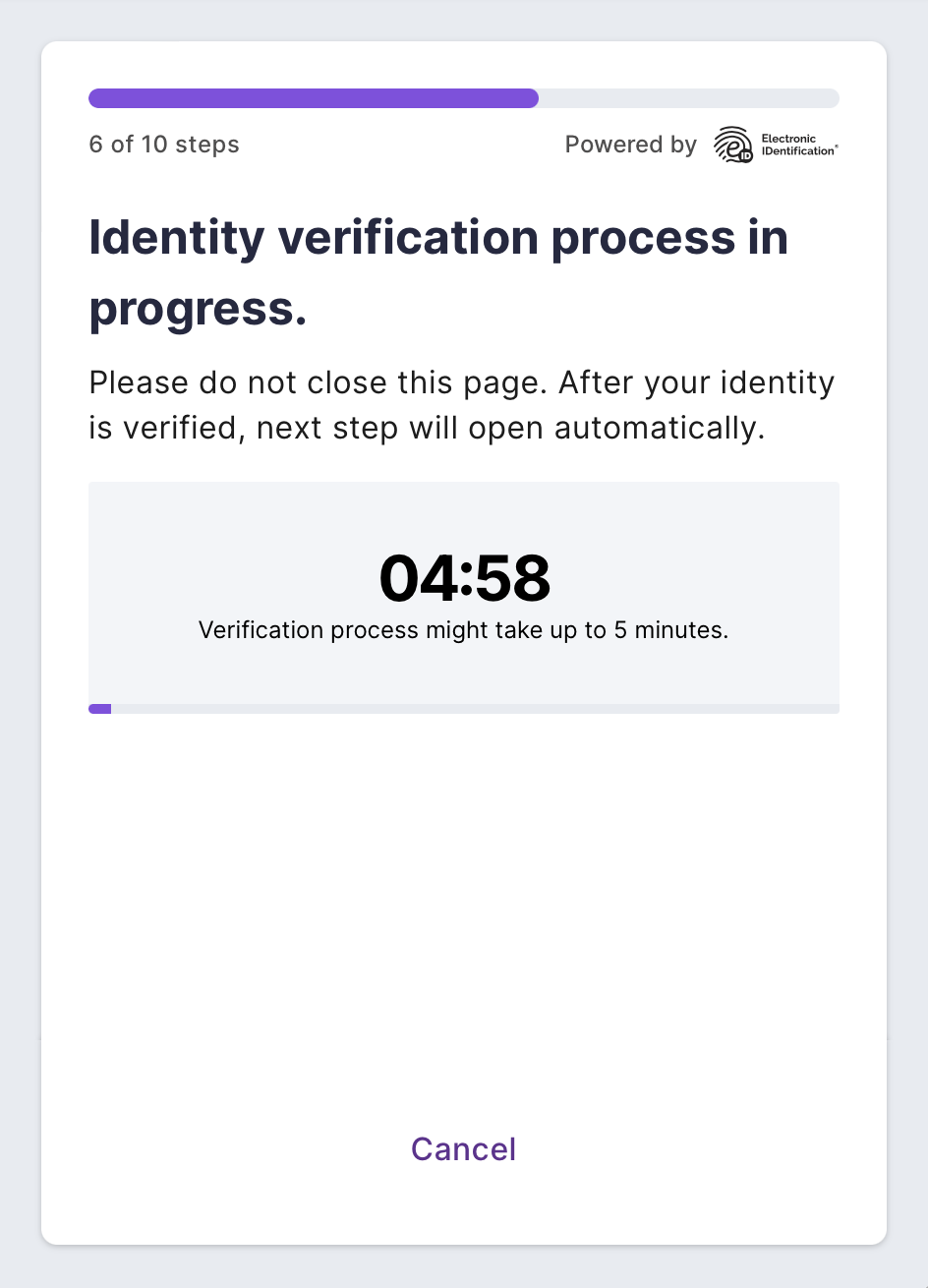
Note: The verification process is expected to take up to 5 minutes. However, don't worry if you end up exceeding this waiting time – sometimes, it can take longer.
2.11. If you successfully passed the identification process, you will see an announcement stating, "Your identity has been verified". Accept the certification terms by marking both of the checkboxes and then press "Continue".
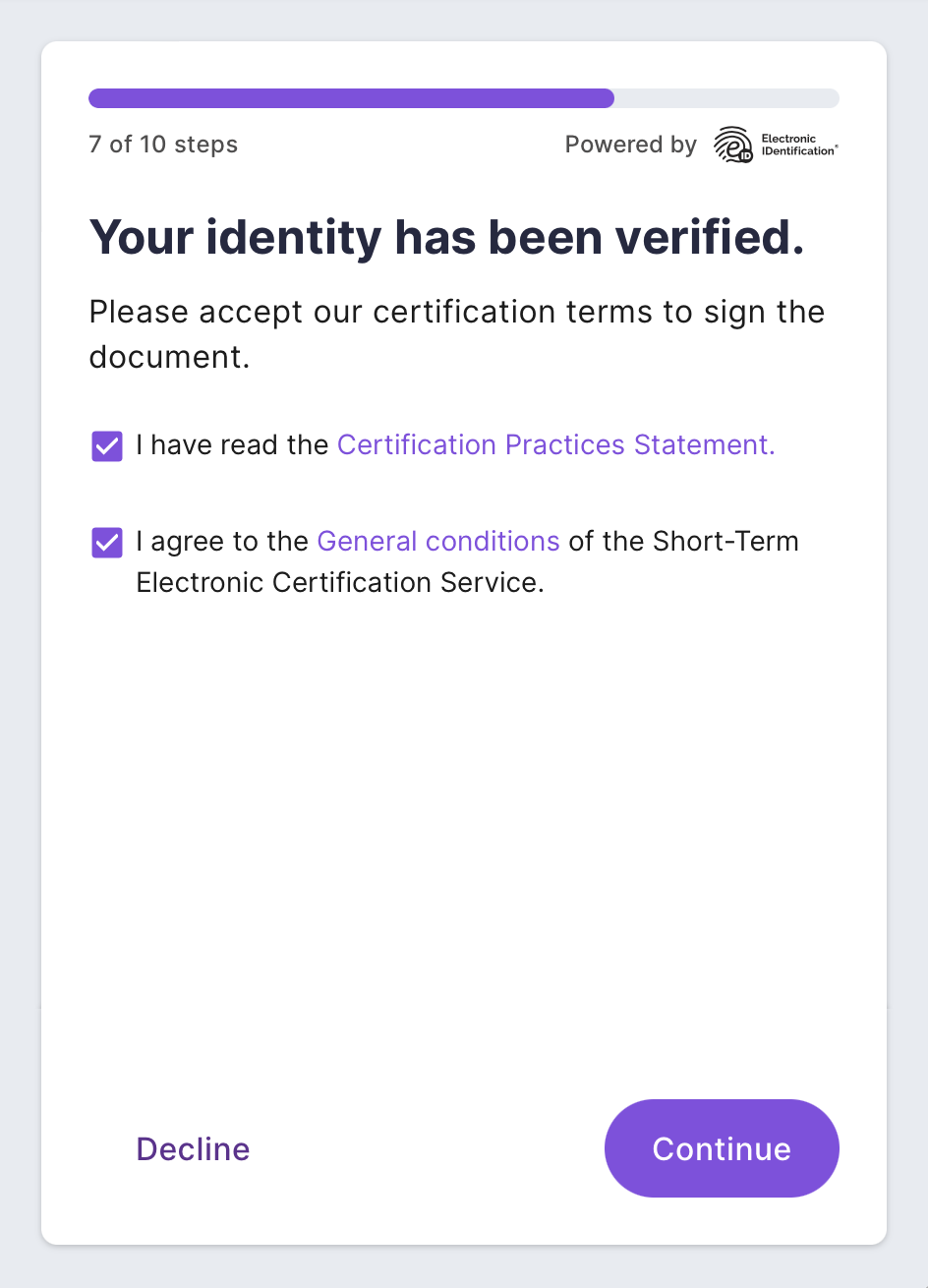
Important!
The following steps must be completed within 5 minutes; otherwise, the identity verification session will expire.
2.12. Choose the appropriate country from the drop-down menu and enter your phone number to receive the verification code for signing the document and then press "Continue".
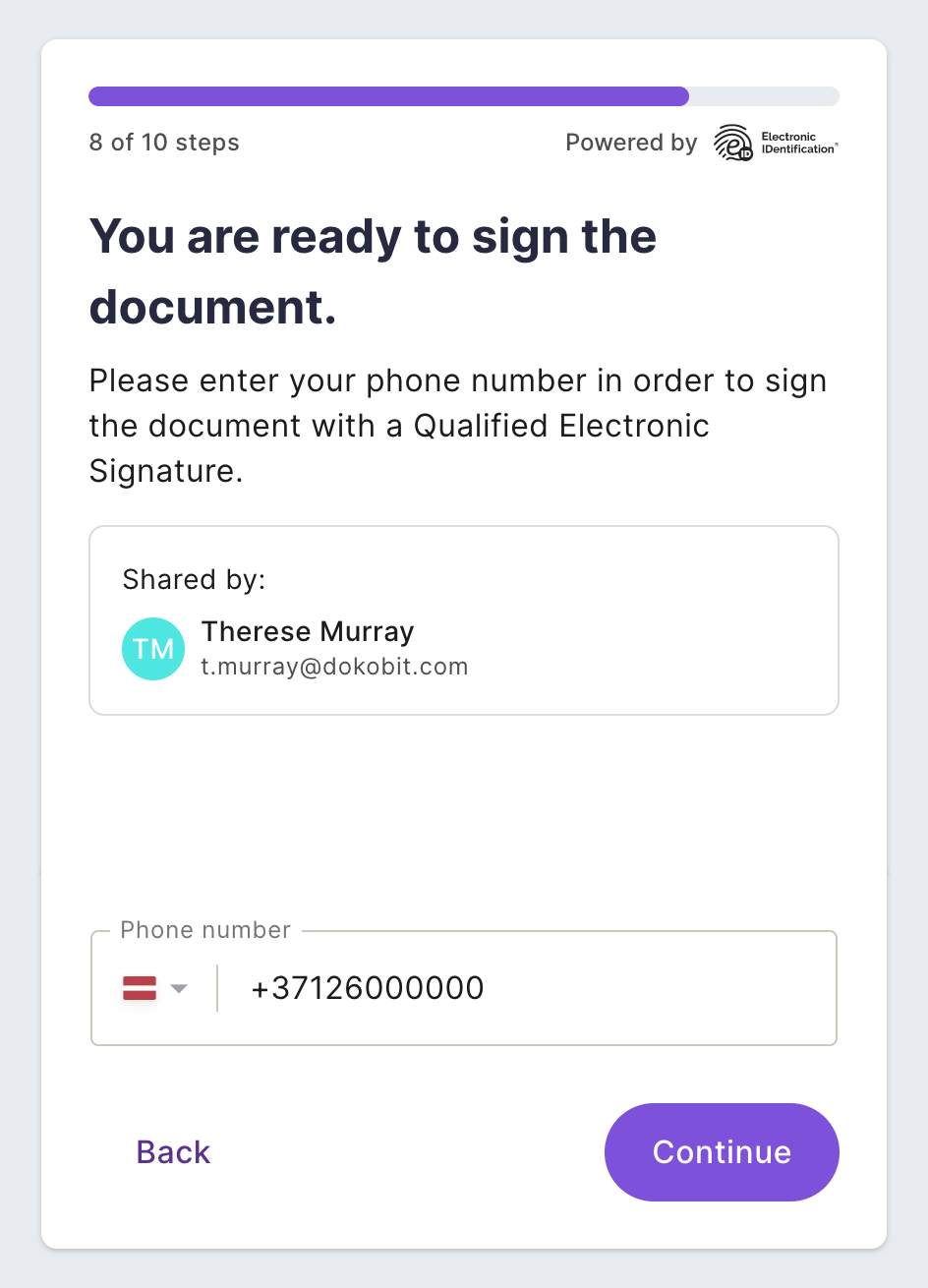
2.13. Enter the code that was sent to your phone.
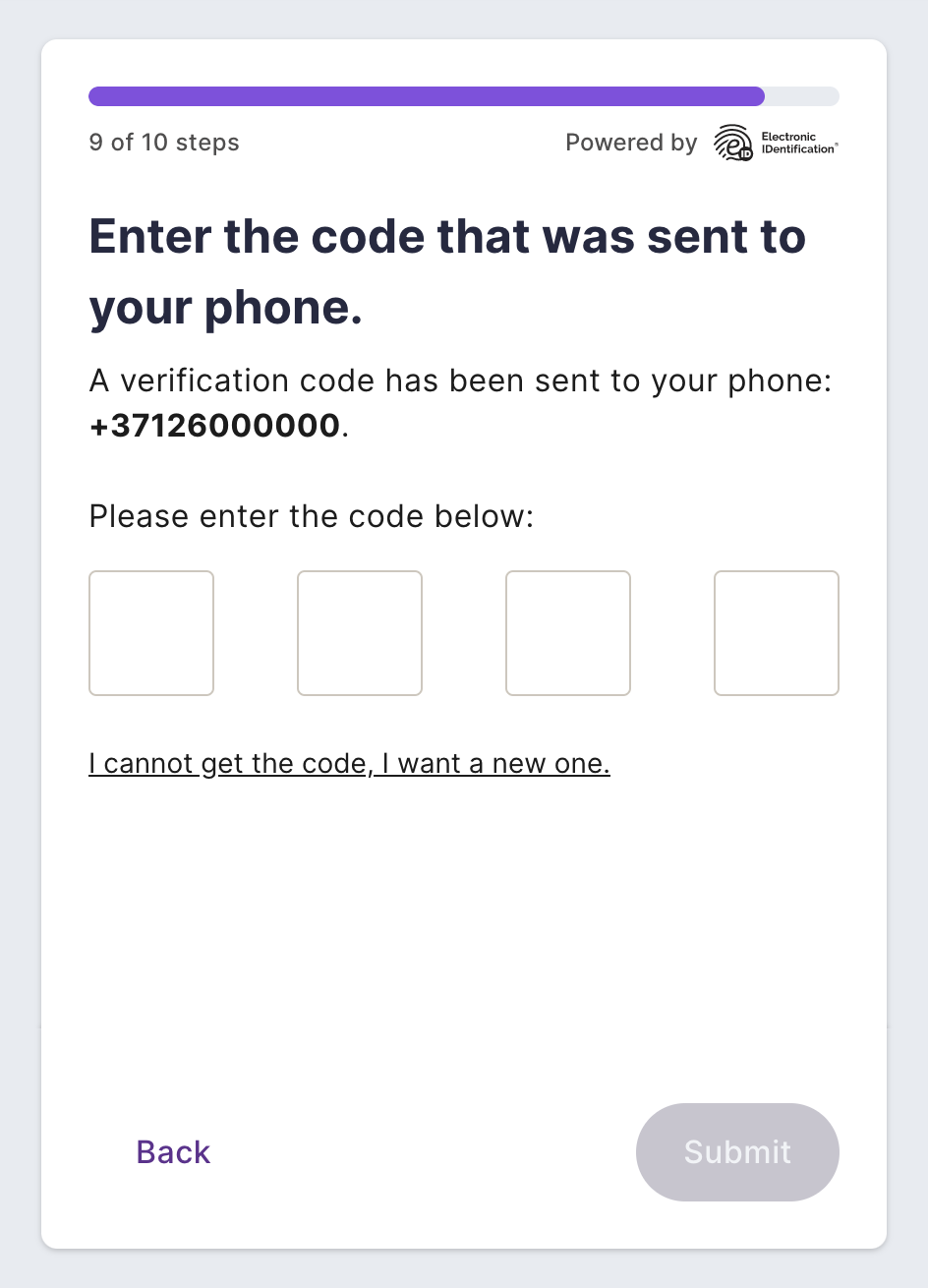
Note: If for any reason you didn't receive the code, press "I cannot get the code, I want a new one".
2.14. Congratulations, you've successfully signed the document!
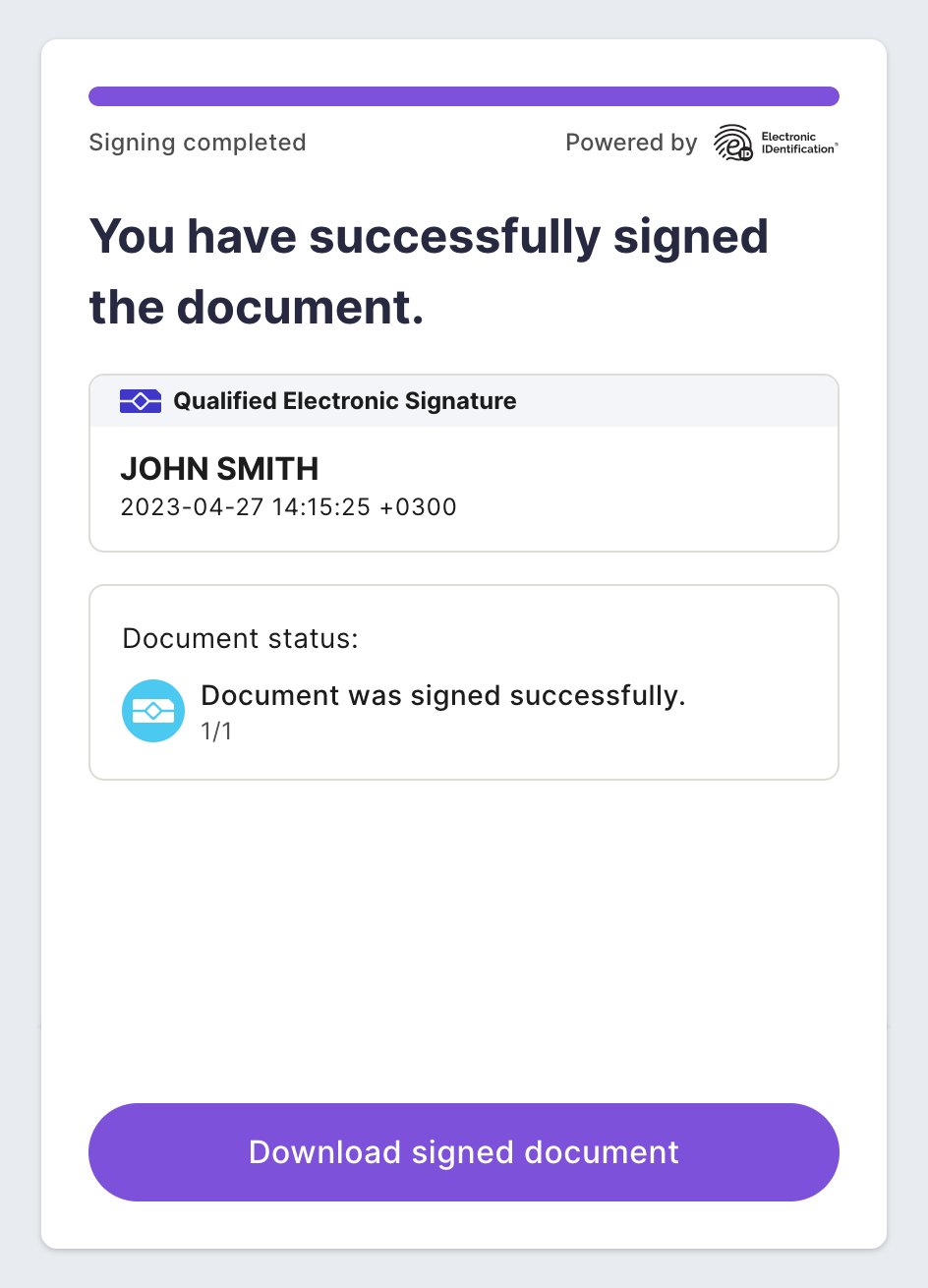
Note: If the document is awaiting signatures from other participants, the link to download the file will not be available. Once all participants have signed the document, you will receive the link via email.
How to sign documents using Swisscom
Summary: If you haven't already, you'll need to set up your Swisscom account by going through a one-time video-based identification, which can be done during the process of signing a document. Follow the steps below to find out how:
Open a Dokobit email invitation that you received and press "Review and sign".

2.1. Once you are redirected to the document signing page, in the first drop-down menu, select the issuing country of your ID, and in the second one, choose the Swisscom signing solution.
Note:This signing method will not be available to you if your document was issued by a country that is not listed in the drop-down menu.

2.2. Enter your personal details and press "Continue".

2.3. In the following step, the system will react in one of two ways.
Option 1: If the system detects that your personal details are not linked to an existing Swisscom account, you will need to set one up by going through a one-time video-based identification process. Press "Continue" to initiate this procedure.
Option 2: If the system detects that your personal details are linked to an existing Swisscom account, proceed to step 2.7.
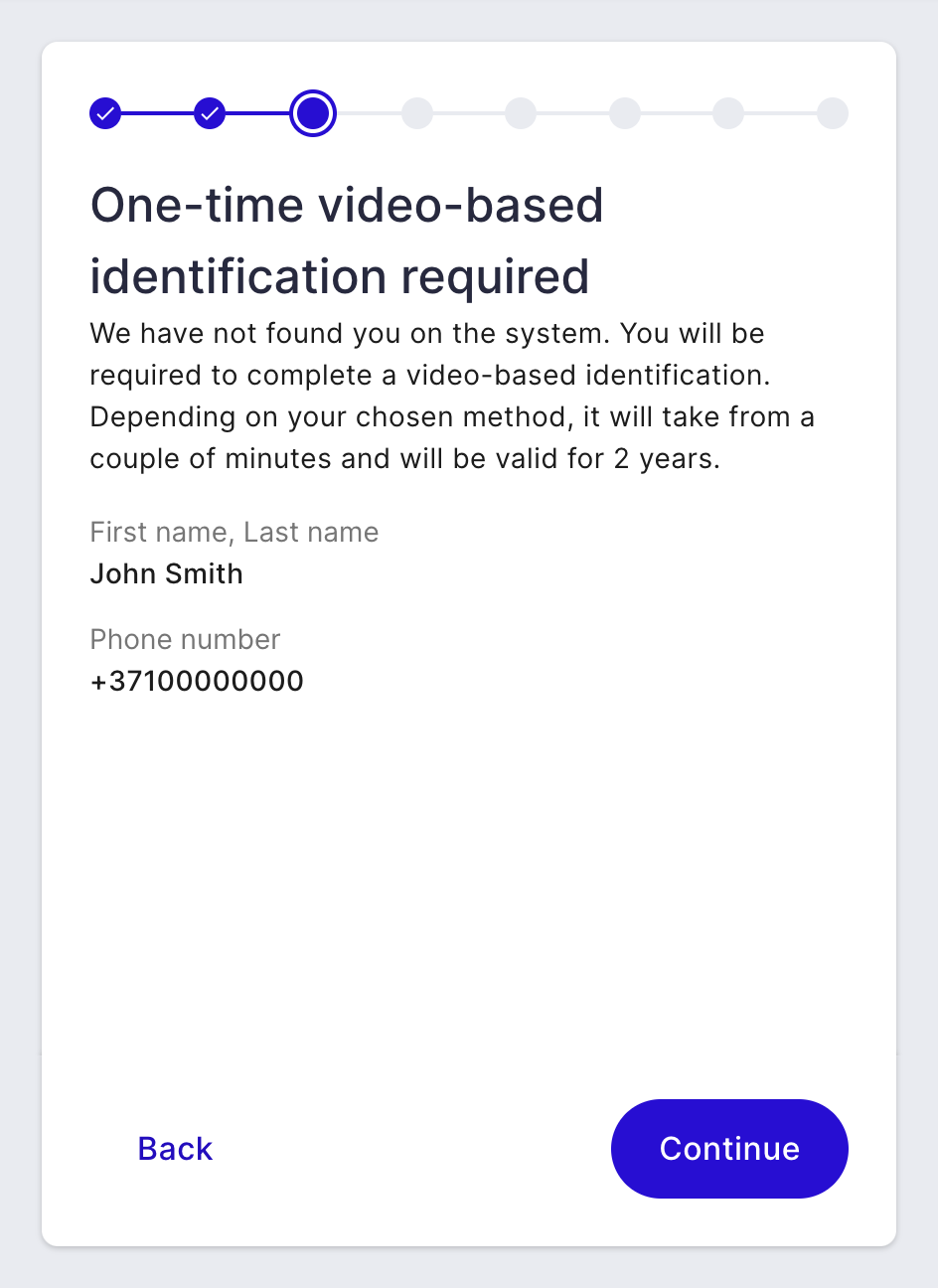
2.4. Next, the system will ask you to activate a Mobile ID account; however, please be aware that this step is optional. Therefore, you will be able to continue in one of two ways.
Option 1 (recommended): If you don't have an active Mobile ID account, press "Activate Mobile ID" and follow the instructions listed between steps 3.0 and 3.6. Once you're finished setting up your Mobile ID account, resume following the steps below.
Option 2: If you do have a Mobile ID account or have decided not to set one up, press "Continue to identity verification". Users who choose not to set up a Mobile ID account will be able to sign documents by instead setting up a password when going through one of the available identity verification methods (see the next step for more information on these methods). To see an example of how the password is created, go to the additional instructions for Selfie-Ident and see step 4.16.
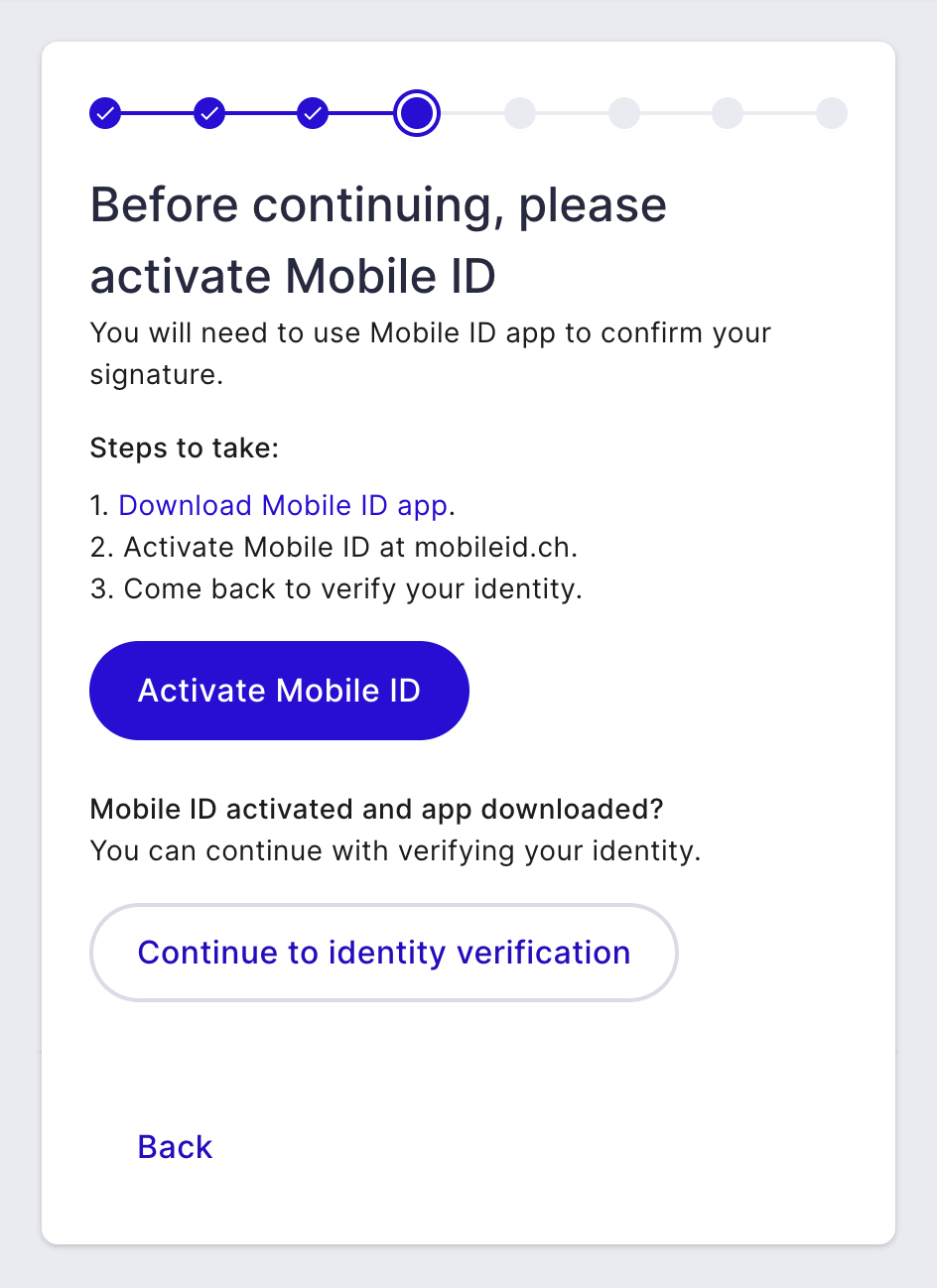
2.5. Pick an identity verification method and press "Continue" (additional information on each method is provided further down).
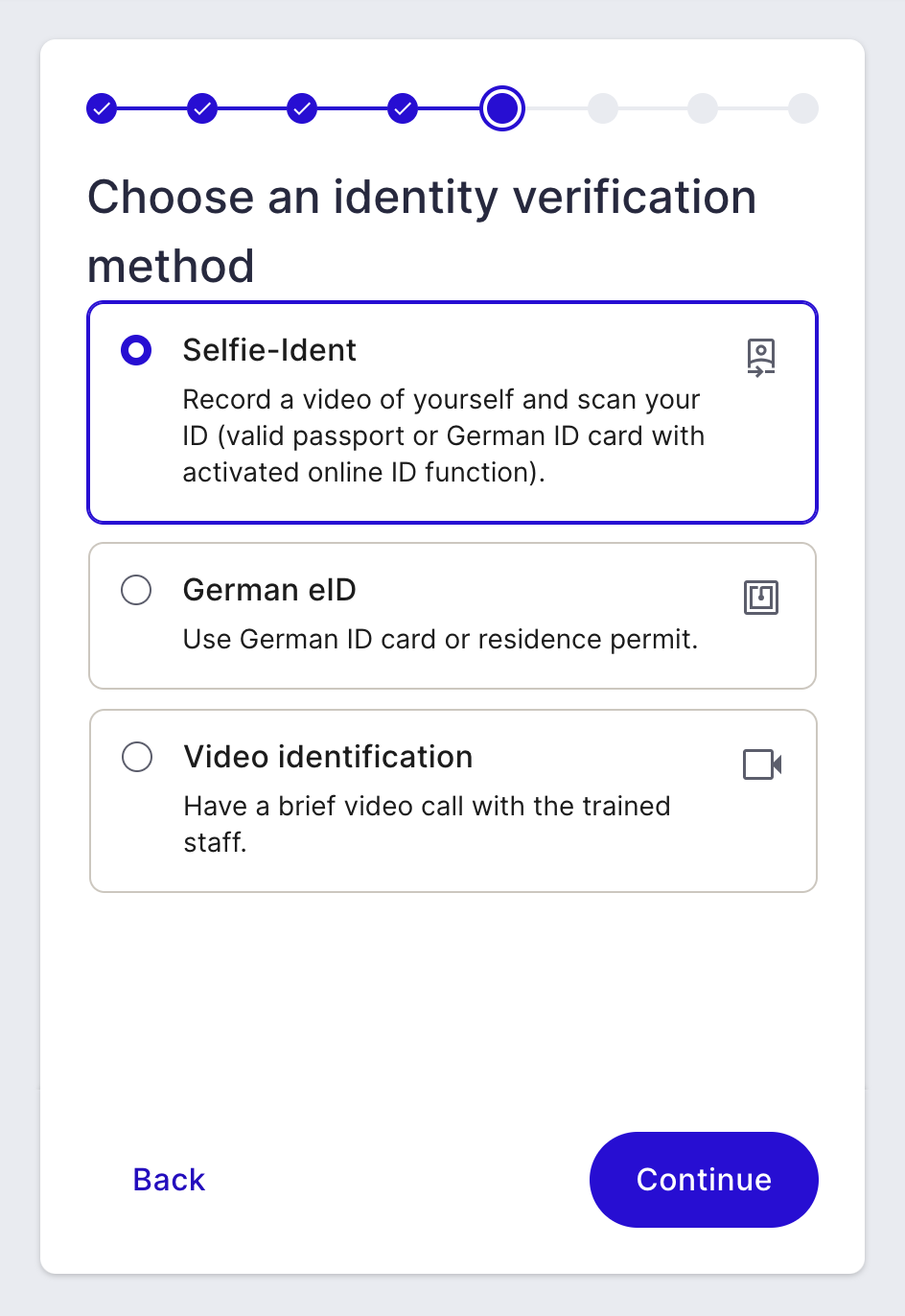
A BRIEF OVERVIEW OF EVERY AVAILABLE IDENTITY VERIFICATION METHOD
Available internationally:
- Selfie-Ident: Verify your identity with the help of your smartphone by using its NFC to scan your ID and the built-in camera to capture a video of your face. Further instructions are available. → here.
- Video identification: Verify your identity through a video call service by talking to a live agent. Further instructions are available. → here.
For German citizens and residents only:
- German electronic ID Verify your identity with a German ID card or residence permit by using a smart card reader.
2.6. Once the identification process is complete, return to the initial signing window and press "Continue" to proceed with signing the document.
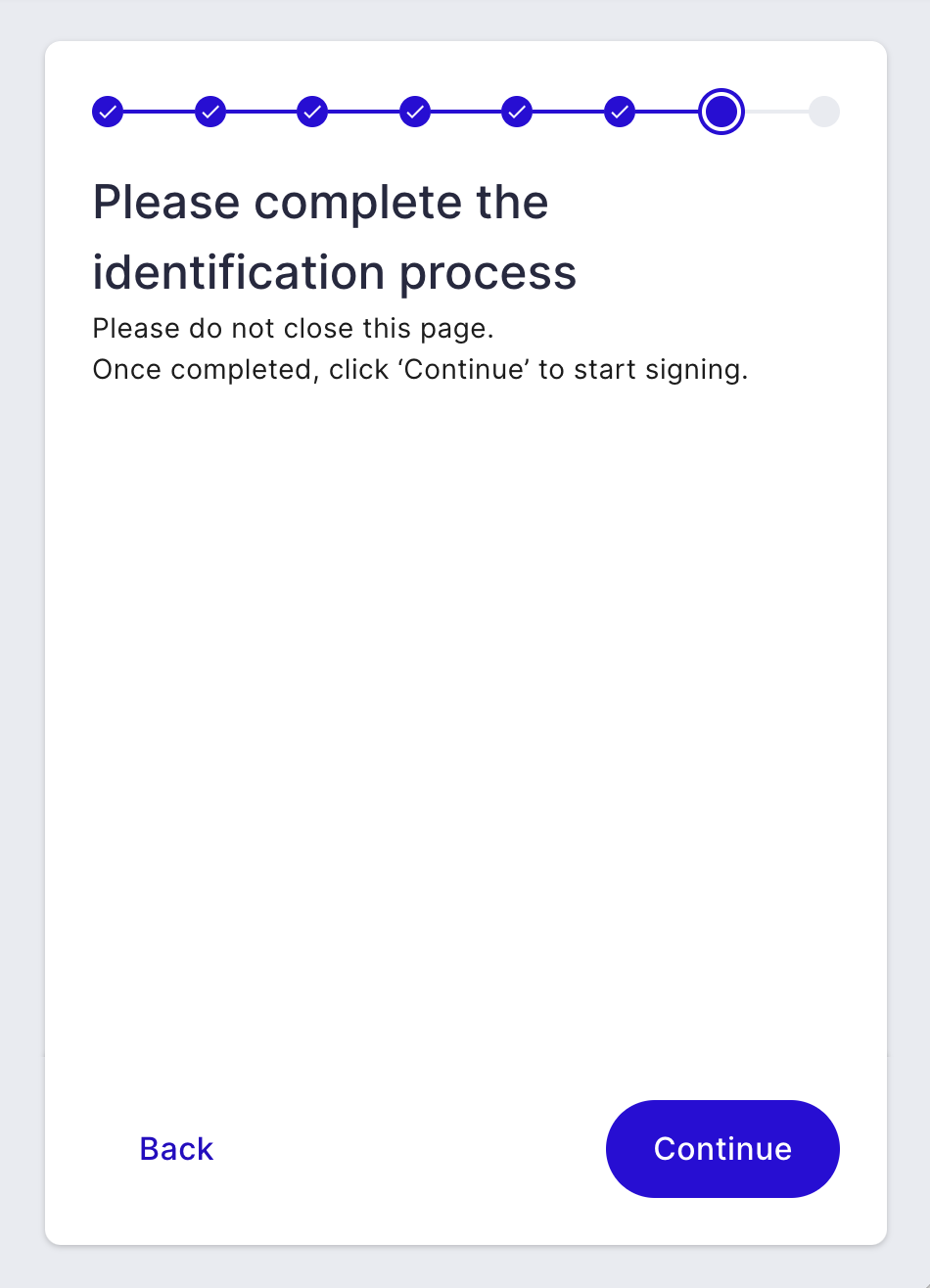
2.7. Here the system will ask to confirm your identity/the signing action in one of two ways.
Option 1: Through the Mobile ID app.
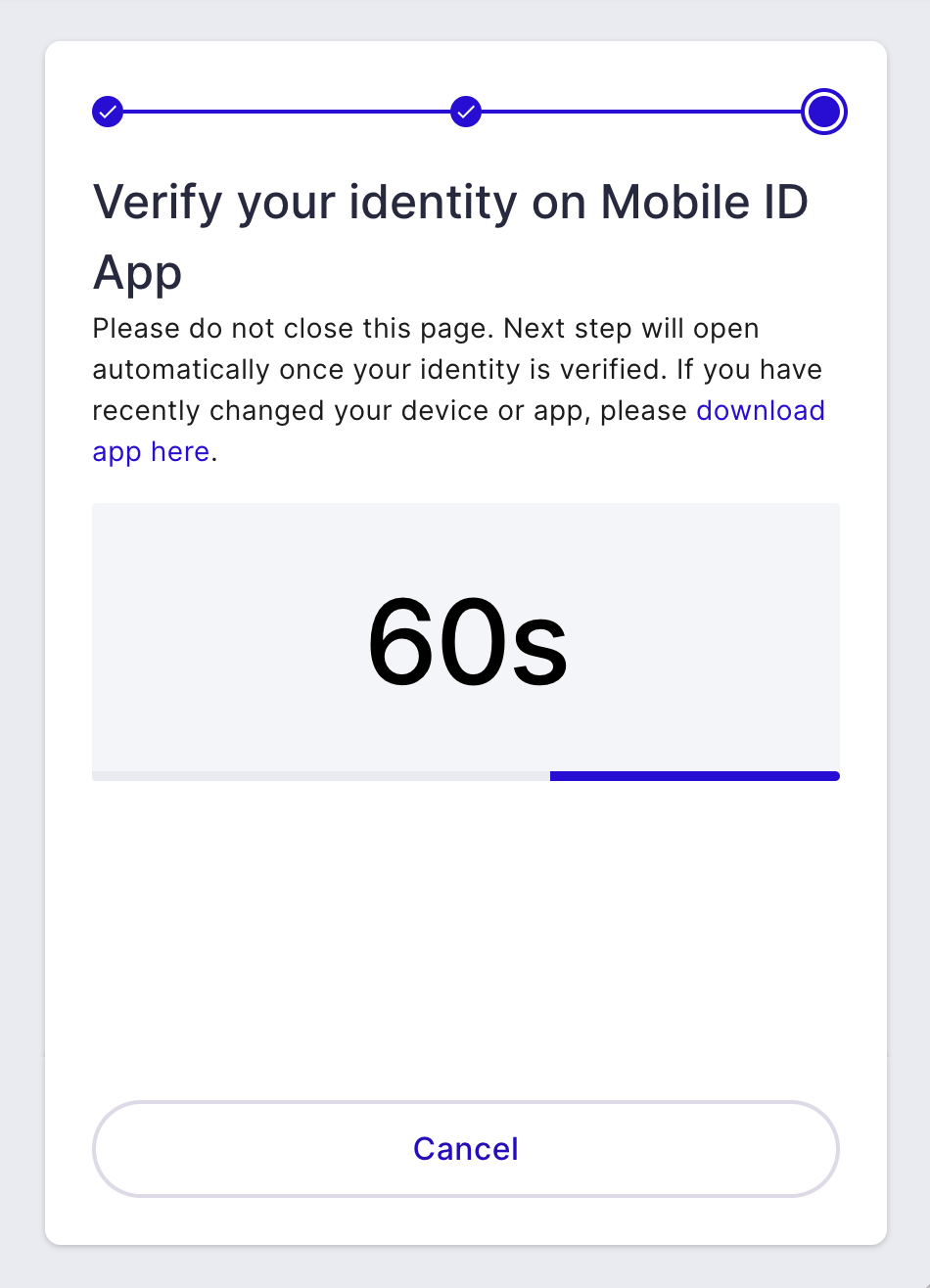
Option 2: By first entering a password that you created during your identity verification and then following it up with an OTP via SMS.
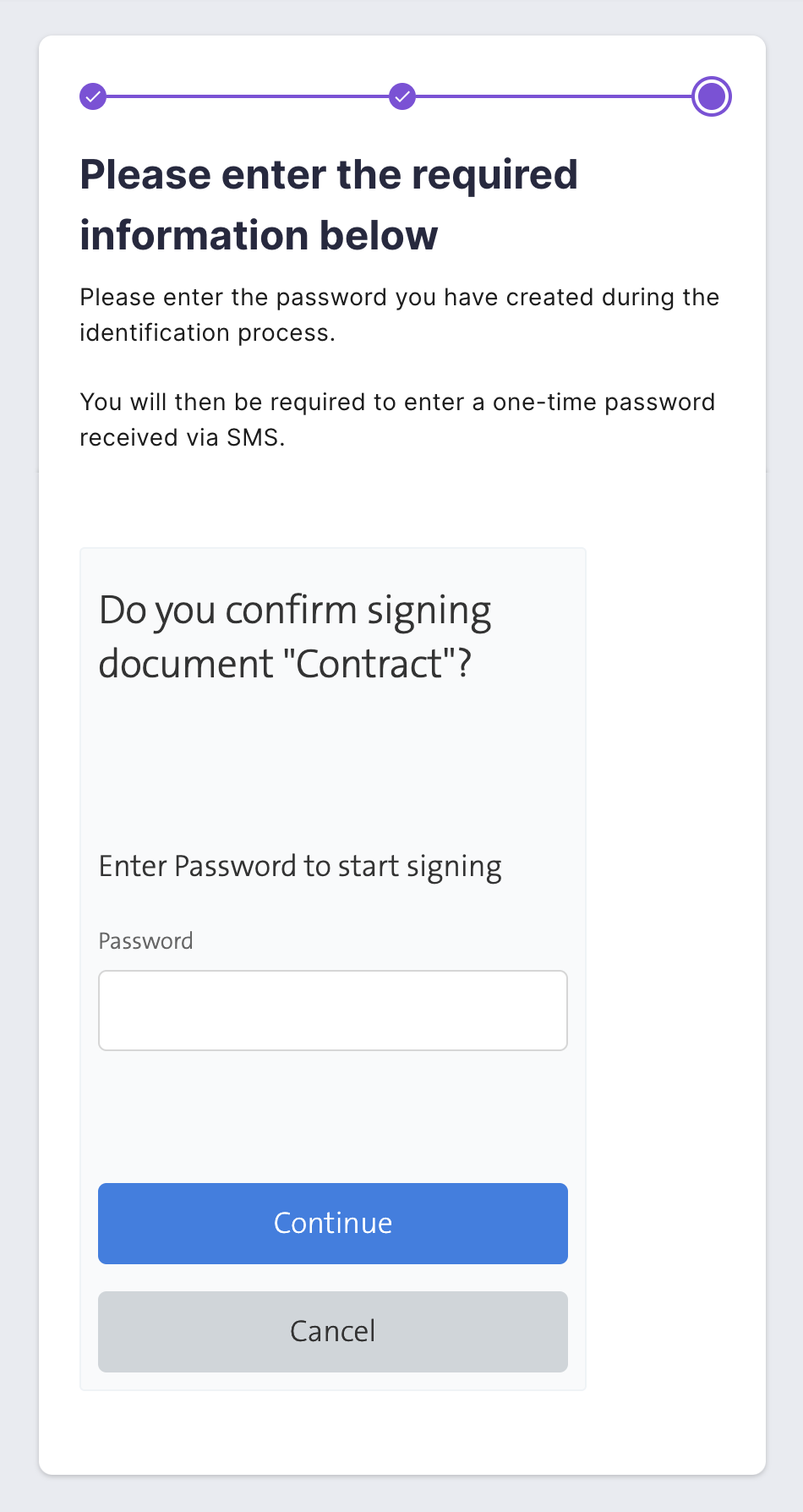

2.8. Once the document is successfully signed, a message similar to the one in the image example below will be displayed.

Additional instructions: setting up Mobile ID
Summary: A Mobile ID An account can be created to simplify authentication when signing documents using Swisscom. Follow the steps below to find out how. ↓
3.0. As described in step 2.4., press "Activate Mobile ID" to get redirected to www.mobileid.ch.

3.1. Once you're redirected to www.mobileid.ch, choose the appropriate country code, enter your phone number, and press "Next".

3.2. You will receive an SMS with a verification code. Please enter this code in the corresponding fields on the website and click "Next".
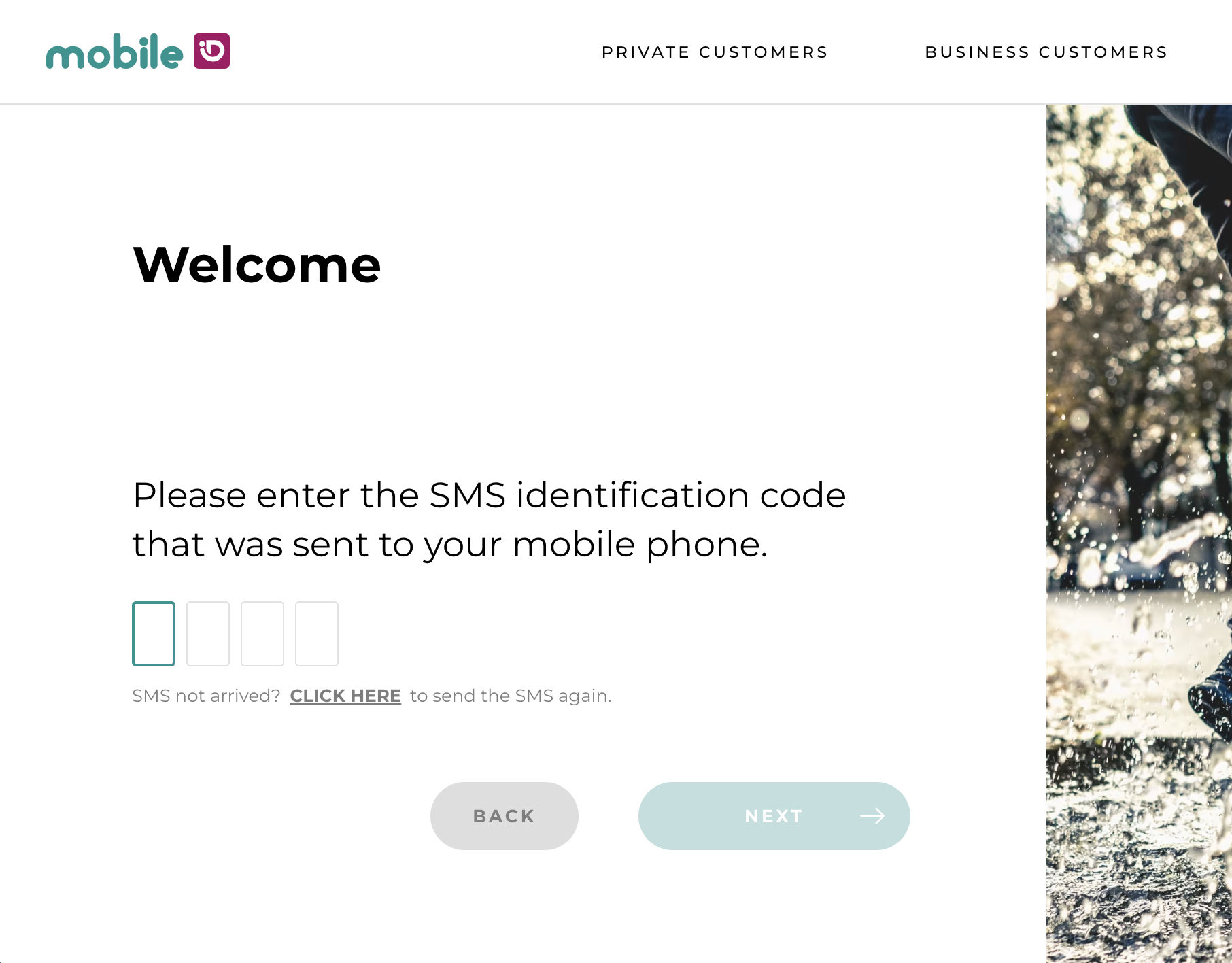
3.3. Then, you will be taken to the Mobile ID dashboard. In the section for "Activate Mobile ID", press "Activate".

3.4. Mark the checkbox to agree to the terms and conditions, and press "Next".
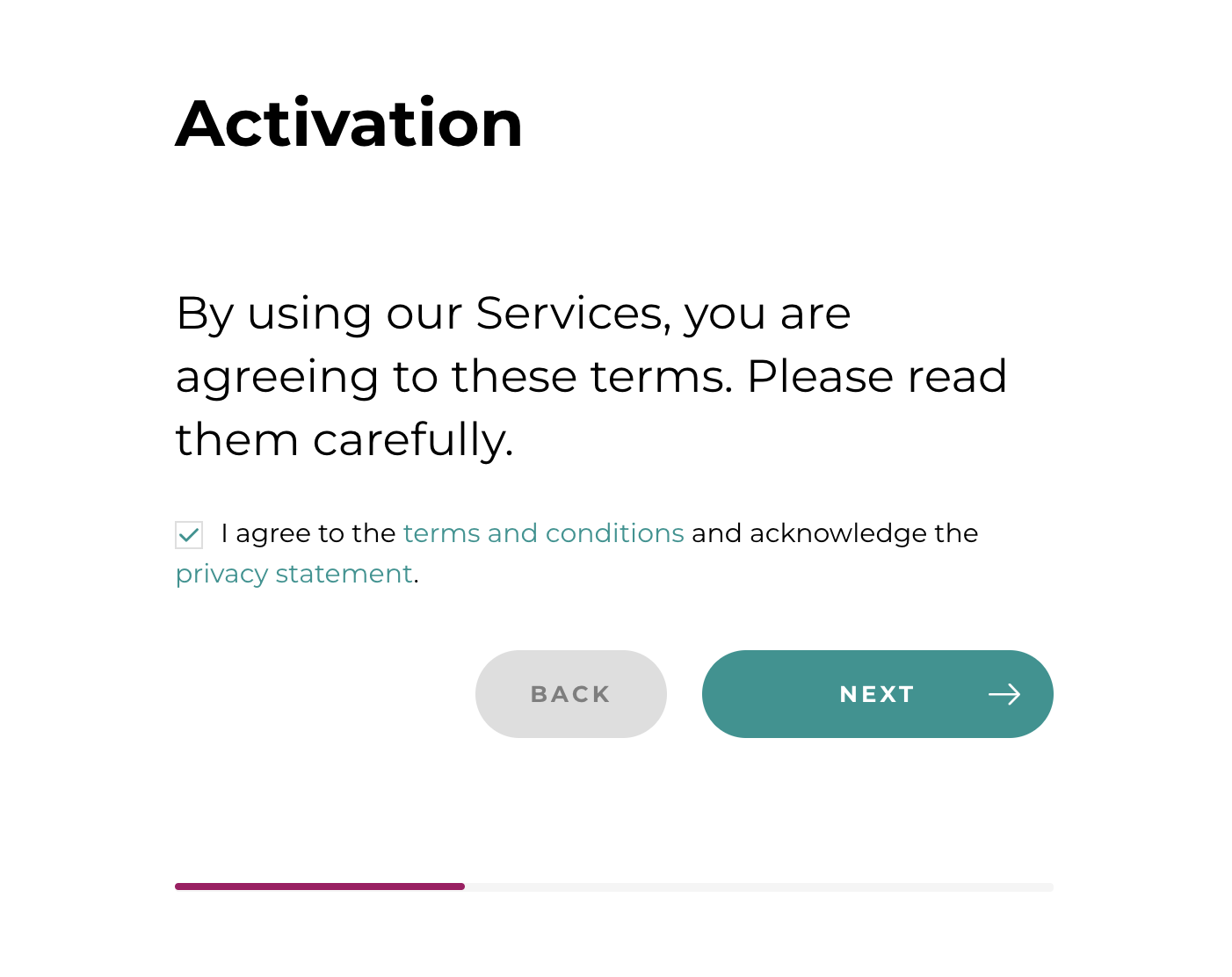
3.5. Download the Mobile ID app on your phone and use it to scan the QR code, as seen in the example image below.
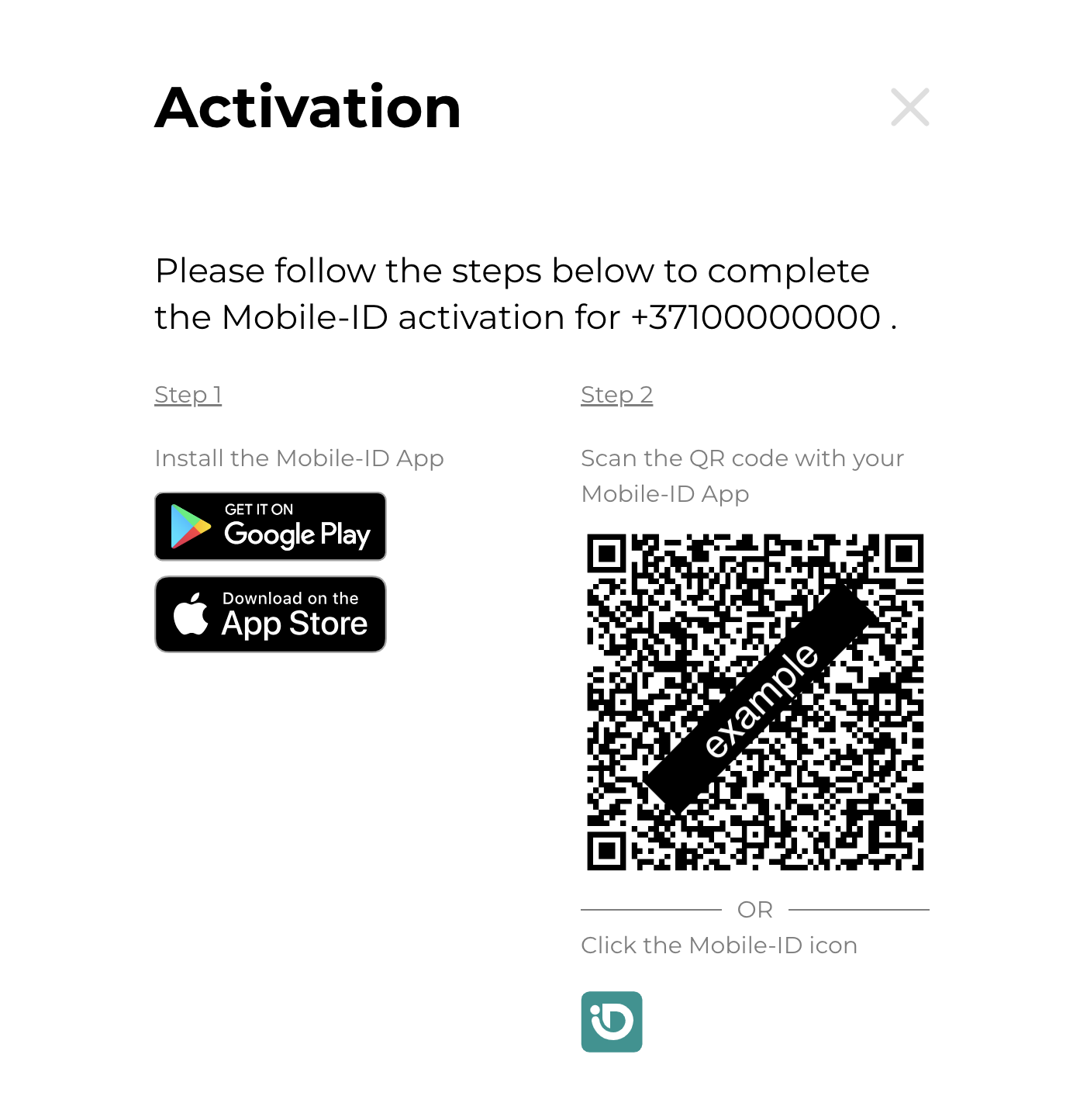
3.6. After scanning the QR code, the Mobile ID account will be activated, and the dashboard will display a recovery key that can be saved for future reference.
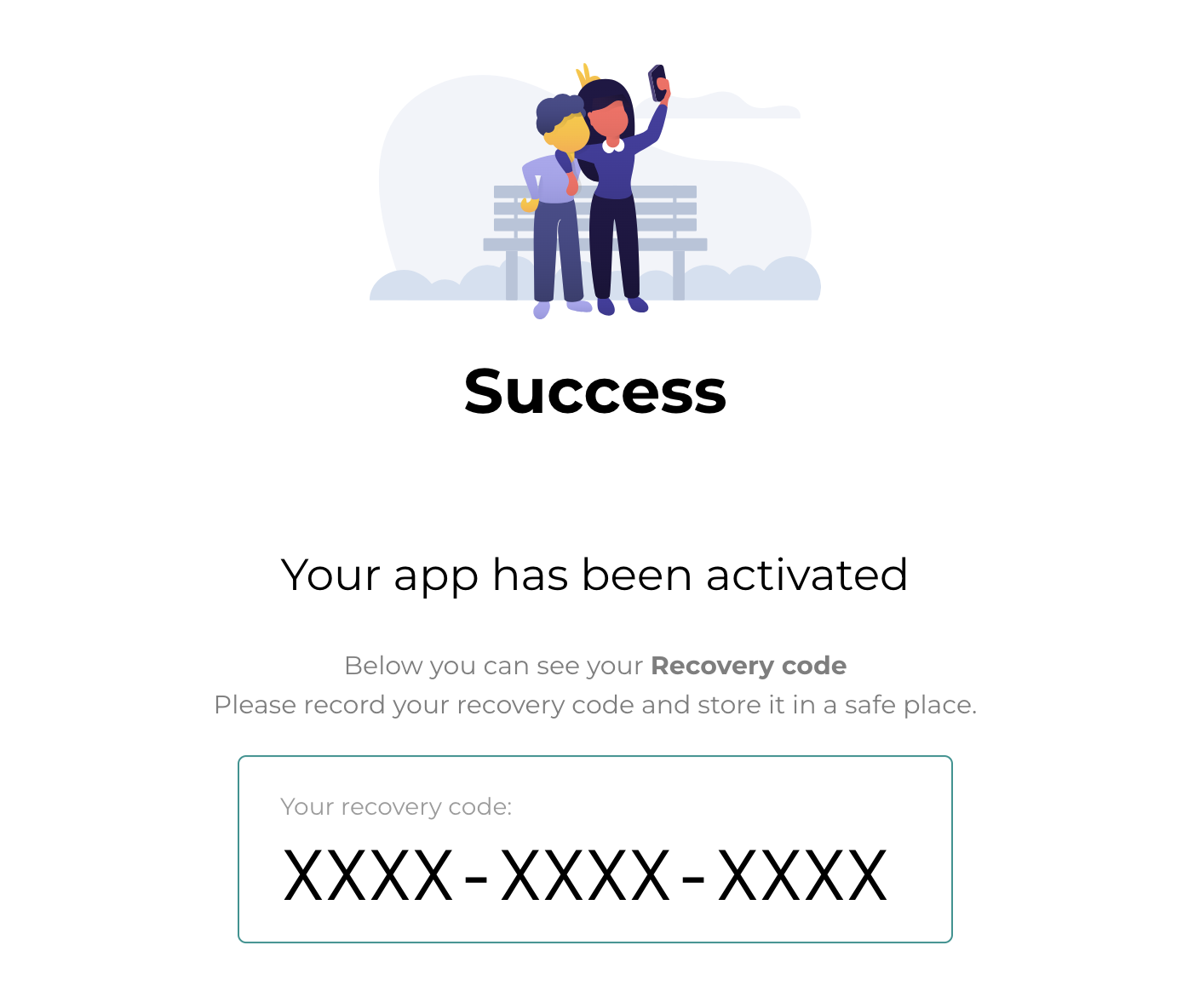
Additional instructions: verifying your identity with Selfie-Ident
Summary: Selfie-Ident allows you to verify your identity with the help of your smartphone by using its NFC functionality to scan your ID and the built-in camera to capture a video of your face through the Nect Wallet app. For this method, you will need either a valid German ID card or a passport from one of the supported countries. For further instructions, follow the steps below. ↓
Note: The following steps may vary slightly in order and content for each user, depending on the type of personal ID chosen and how each user interacts with the app.
4.0. When choosing an identity verification method, pick "Selfie-Ident" and press "Continue".

Familiarize yourself with the requirements of the process and press "Start".

4.1. You will then be redirected to https://jump.nect.com/. Here you will be asked to begin the identification process by either scanning the QR code on the left or by sending yourself an SMS with a link on the right.

If the system detects that you don't have the Nect Wallet app, you will be asked to download it from the App Store or Google Play Store.
4.2. Once the app has been downloaded and opened, press "Get started".
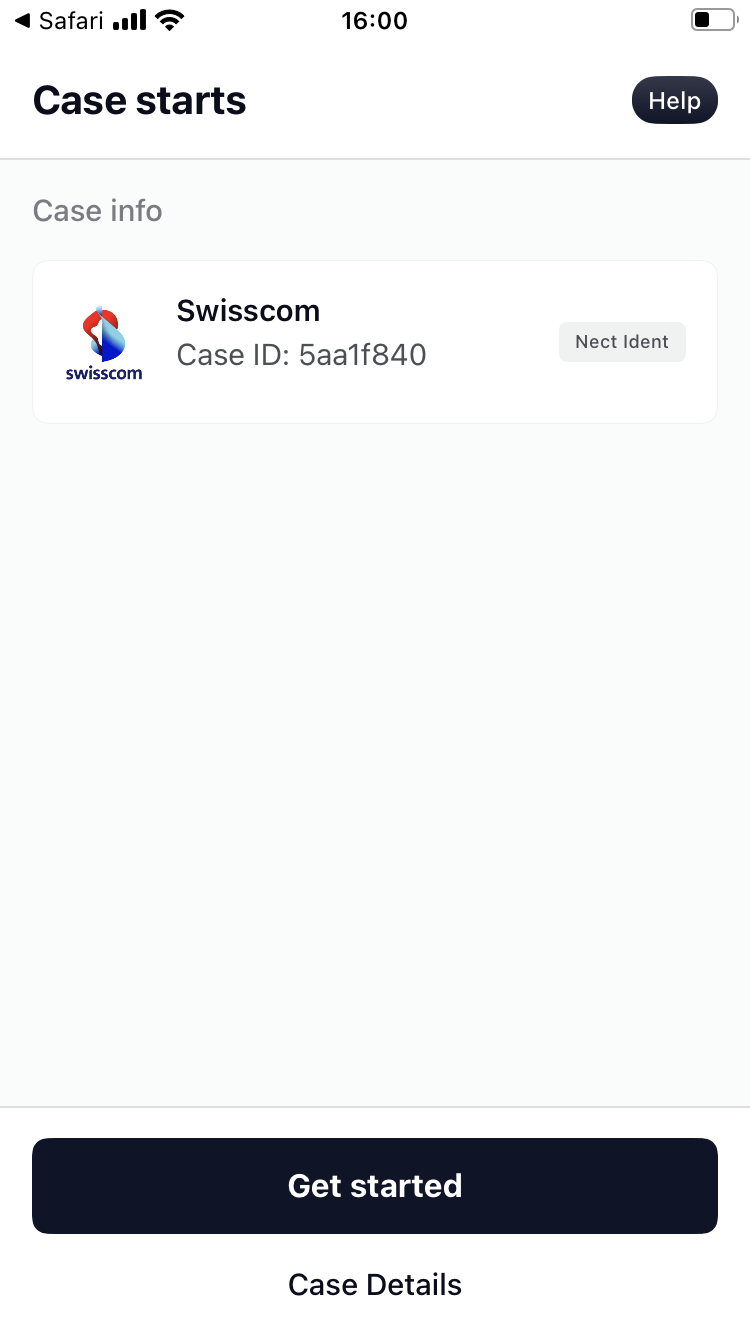
4.3. Familiarize yourself with the requirements of the process and press "Continue".
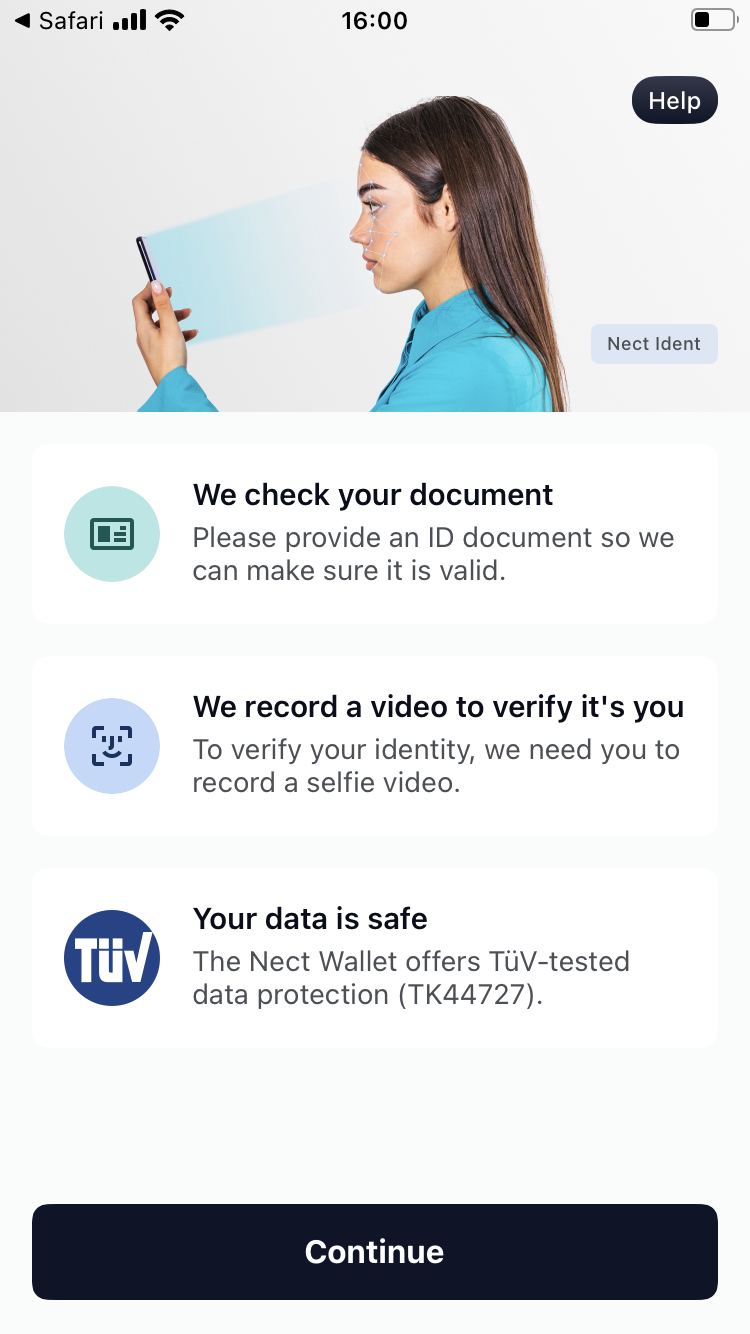
Then mark the checkboxes to agree to the terms and conditions, and press "I understand and consent".
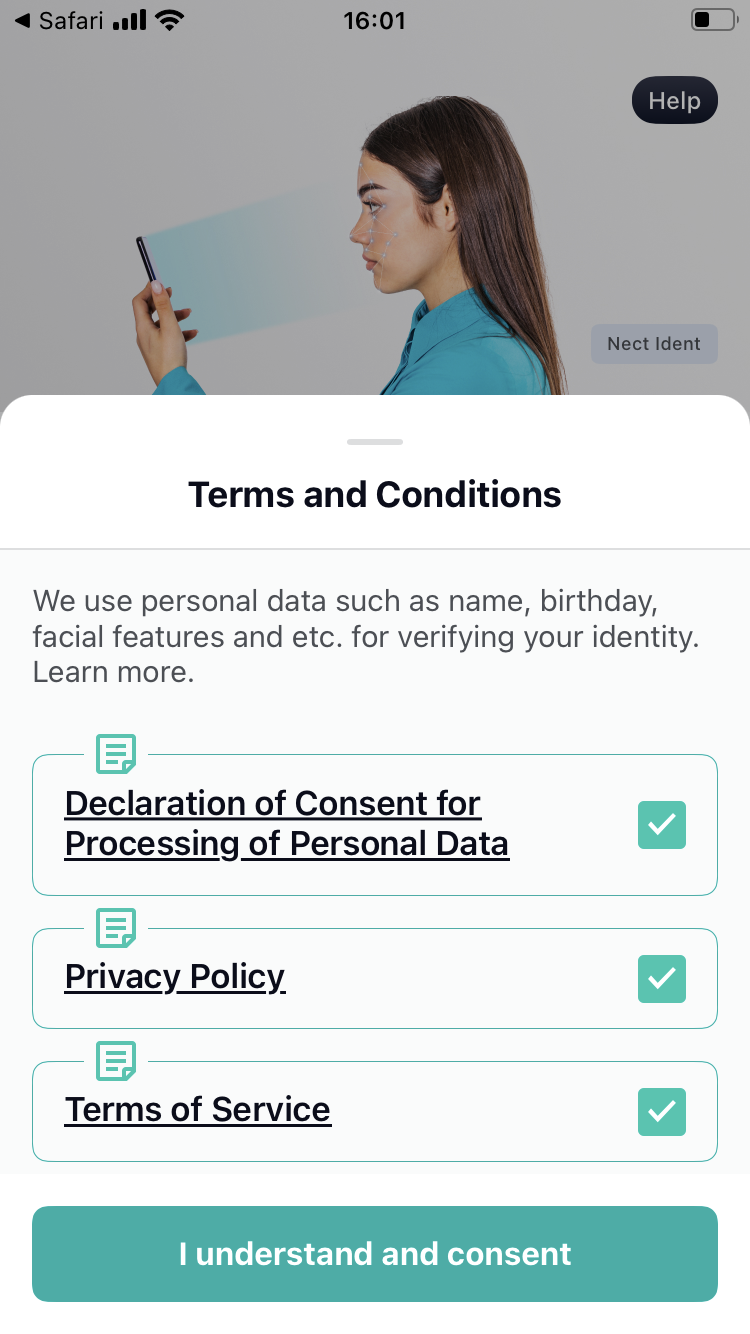
4.4. In the next step, you will be shown a video tutorial. If you choose to skip the video, you will be provided with written instructions on how to properly scan your ID. You may either watch the tutorial or read through the instructions and then press "Continue".
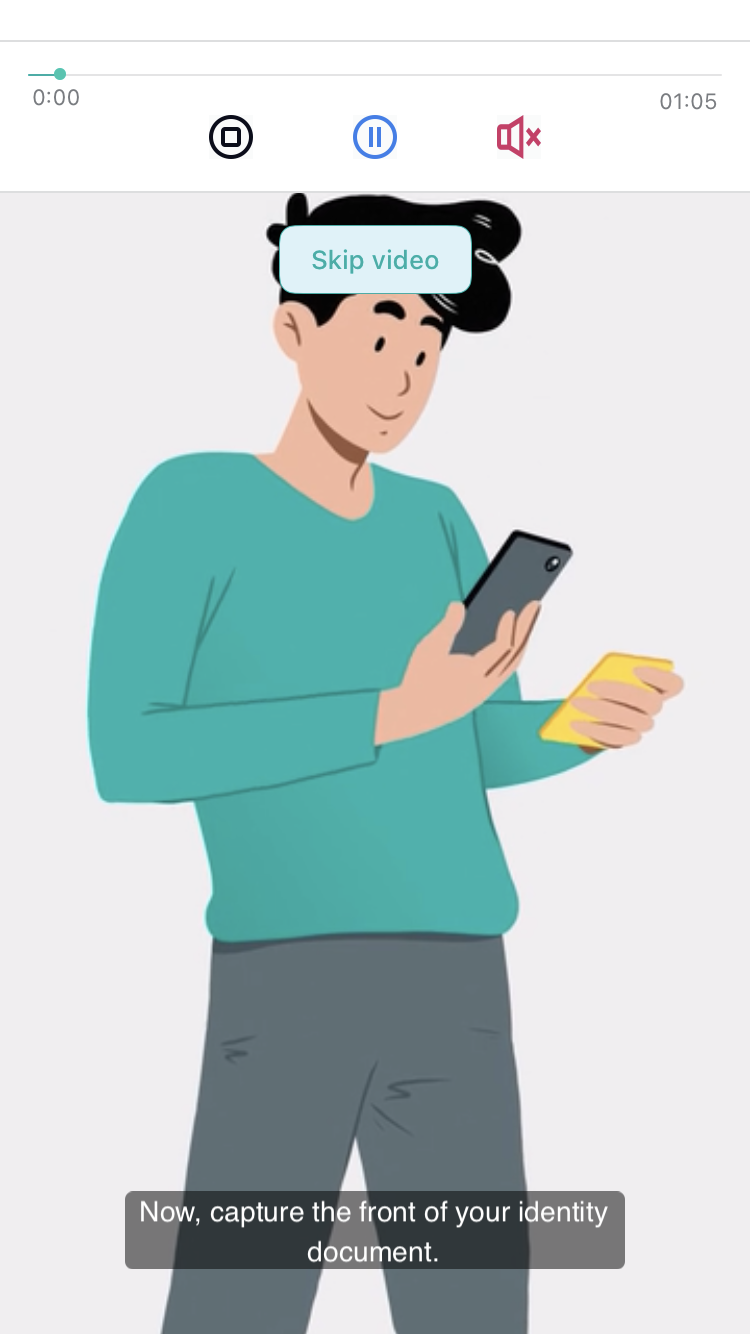
4.5. Get familiar with the next set of instructions and press "Start recording".
Note: Please note that the Nect Wallet The app may list a broader range of supported countries/IDs, but not all of them are supported by Swisscom itself and therefore cannot be used to create this signing tool. Before recording your chosen ID, please consult the list of supported countries at the beginning of this article to ensure a successful registration process.
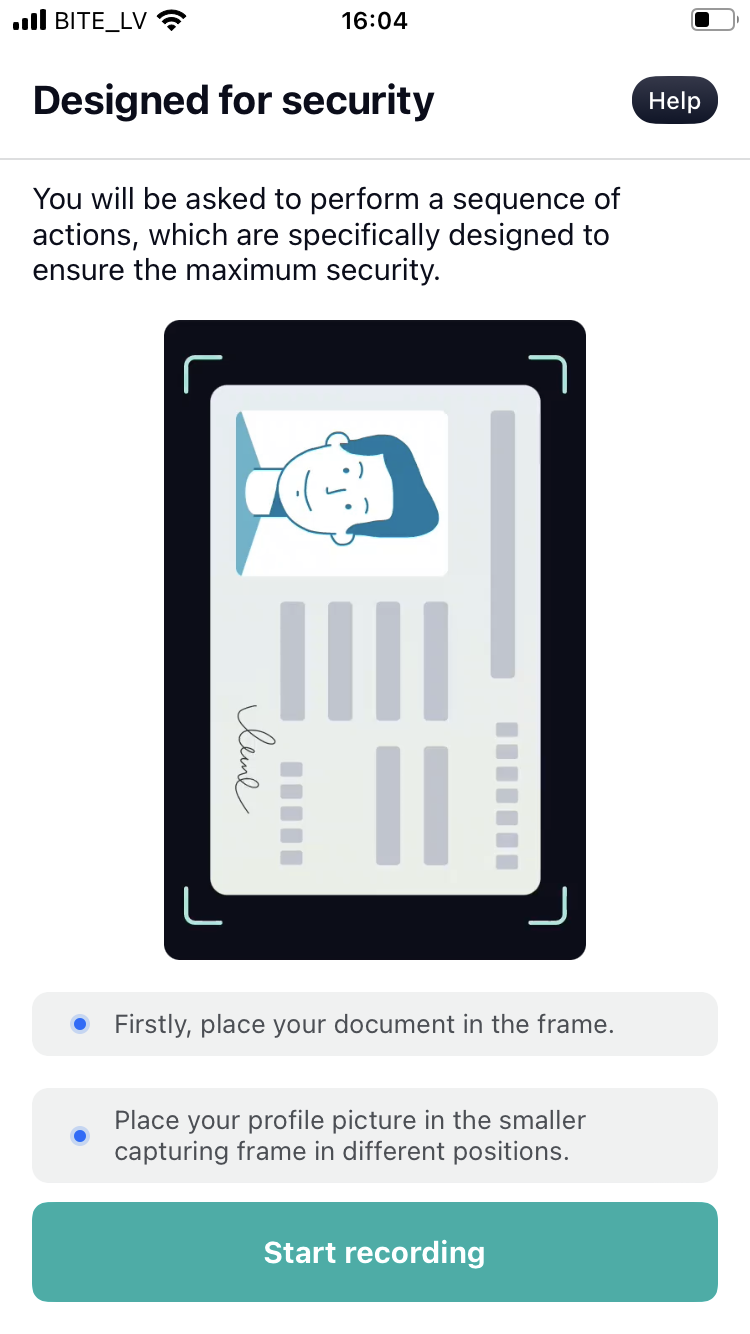
Before the recording begins, you might be required to allow Nect Wallet to access your microphone and/or camera.
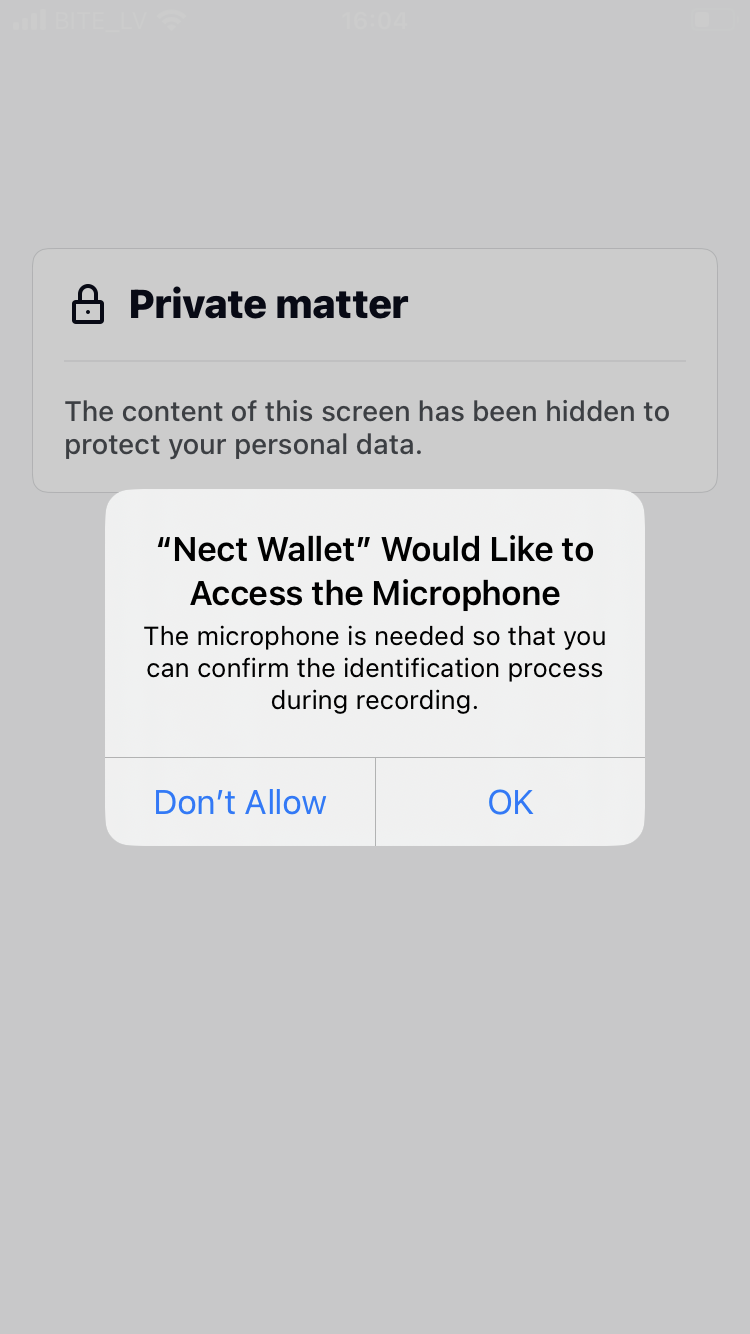
4.6. Once the recording begins, follow the instructions on the screen to scan the front of your document. For ID cards, you will also be required to scan the back of your document.
Note:For demonstration purposes, the camera screen has been blacked out in the following screenshot example.
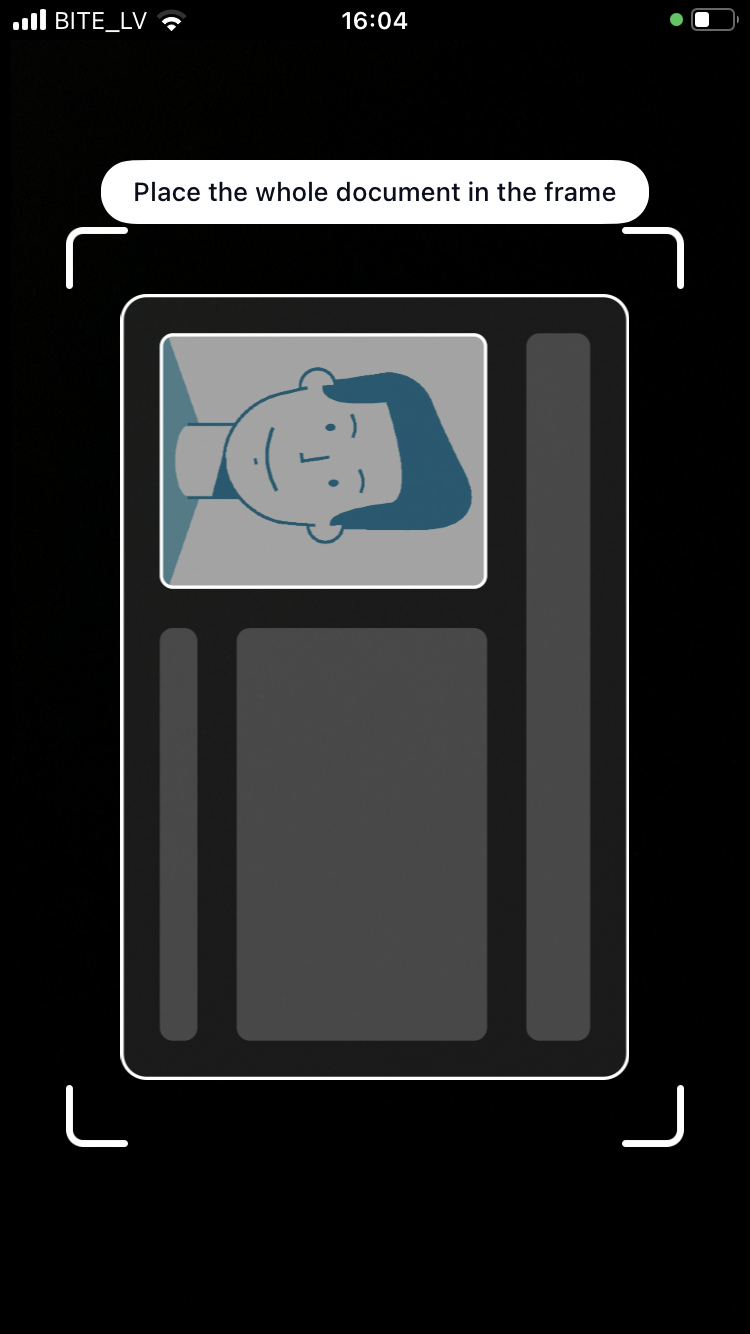
4.7. After the recording is completed, biometric ID holders will be given the option to scan the NFC chip as an additional security measure. Press "Continue". Alternatively, you can press "Skip" to move on from the NFC step (in which case, proceed to step 4.10).

4.8. If you didn't skip the previous step, double-check your data. Make corrections if necessary and press "Continue". Alternatively, you can still press "Skip" to move on from the NFC step.
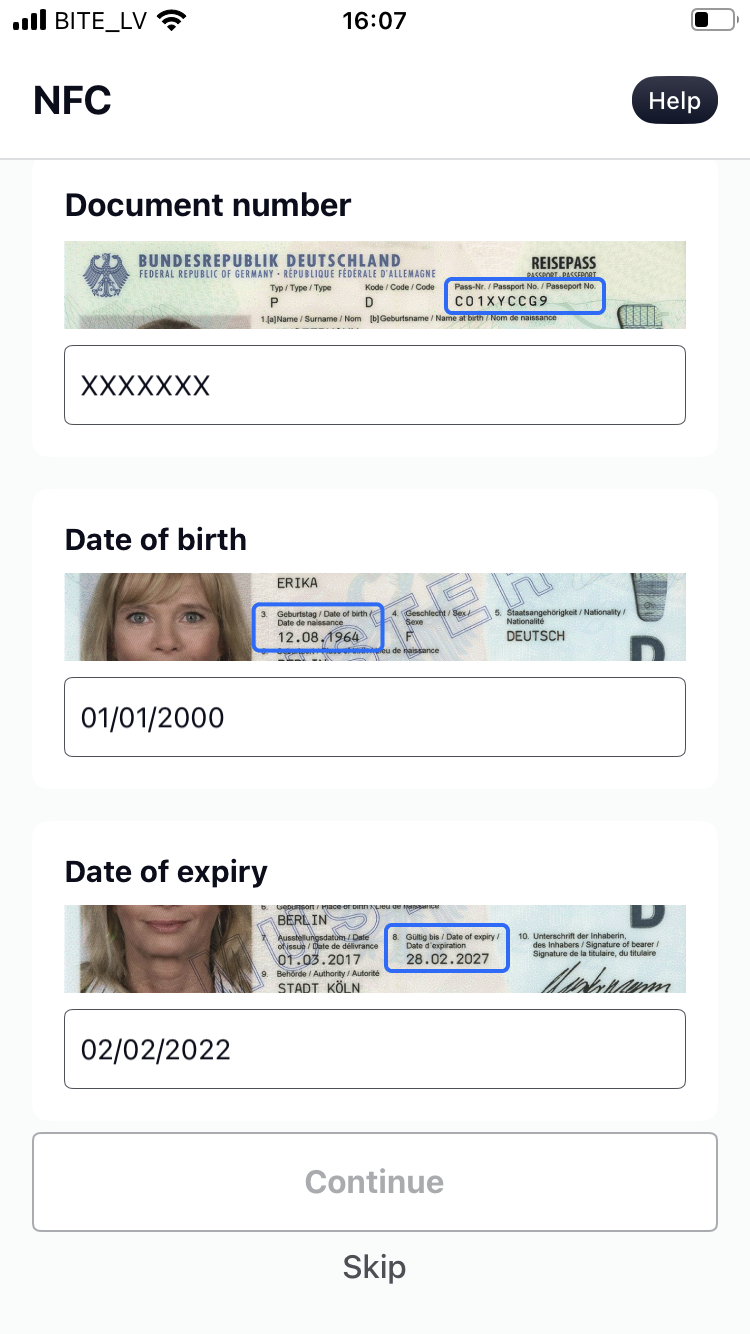
4.9. If you didn't skip the previous two steps, follow the instructions on the screen to scan the NFC chip in your ID.
Note: To successfully scan the NFC chip, phone cases and passport covers should be removed, and the smartphone should be directly placed on top of the passport. If you're experiencing difficulties scanning the chip, try placing the smartphone on different parts of the document.
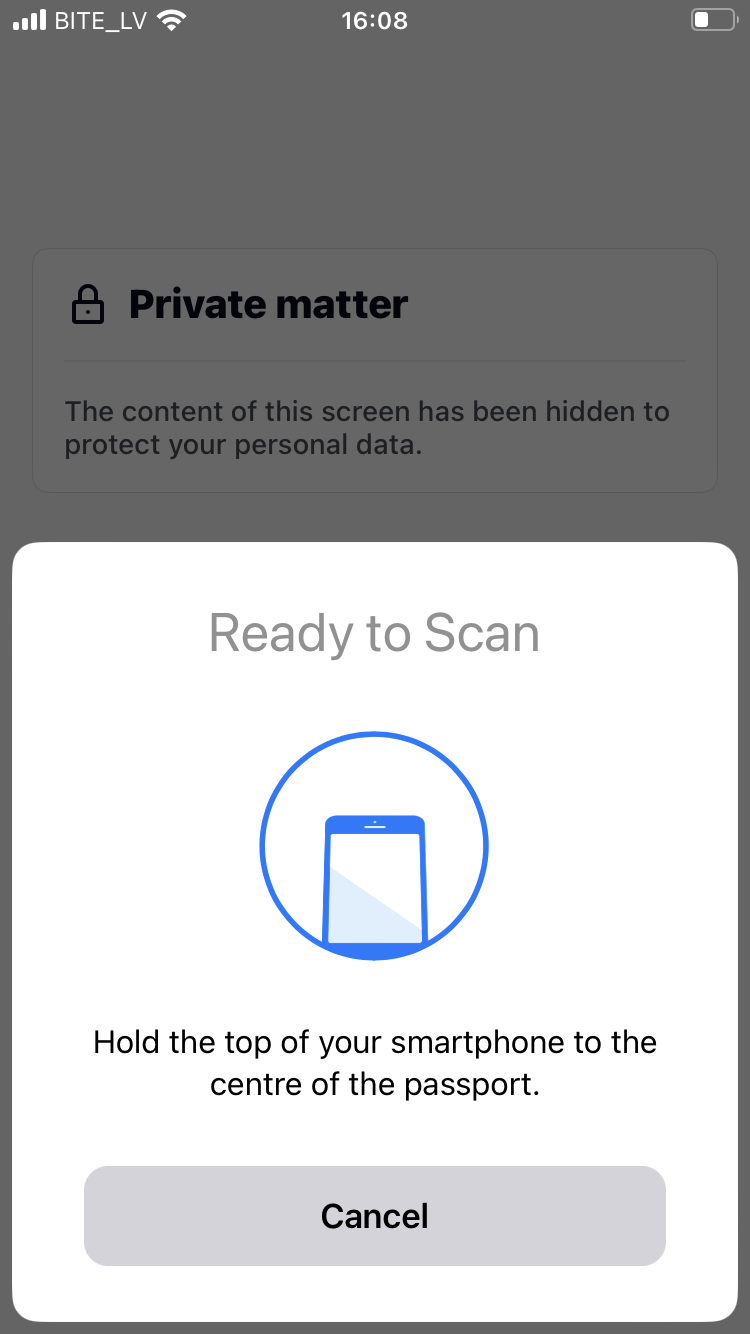
4.10. Next, you will be shown another video tutorial. If you choose to skip the video, you will be shown written instructions on how to correctly perform a face scan instead. You can either watch the video tutorial or familiarize yourself with the written instructions, and then press "Continue".
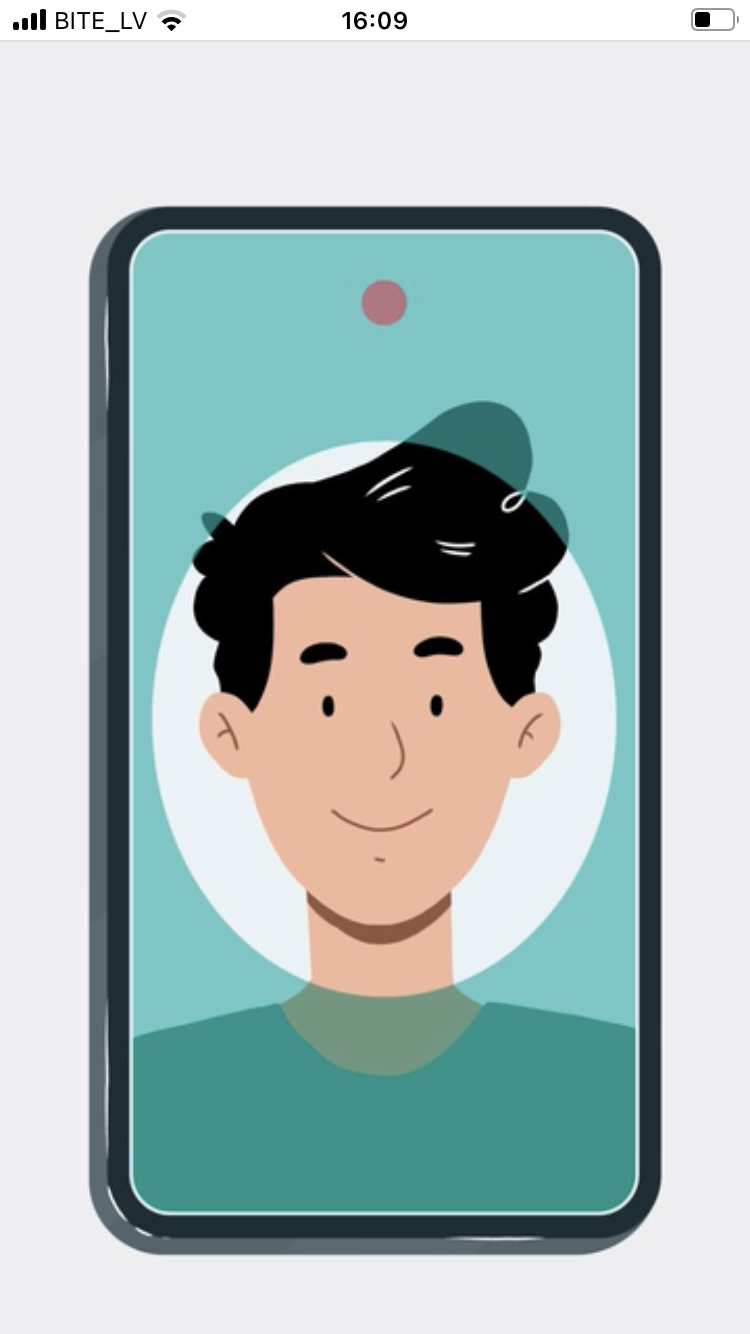
4.11. Record a video of yourself and repeat aloud the two words shown on the screen. Repeating these words is necessary to ensure that you are a living person and not just a mask or a photo being held in front of the camera.
Note:For demonstration purposes, the camera screen has been blacked out in the following screenshot example.

4.12. Once the recording is completed, enter your full name in the provided field and press "Continue".
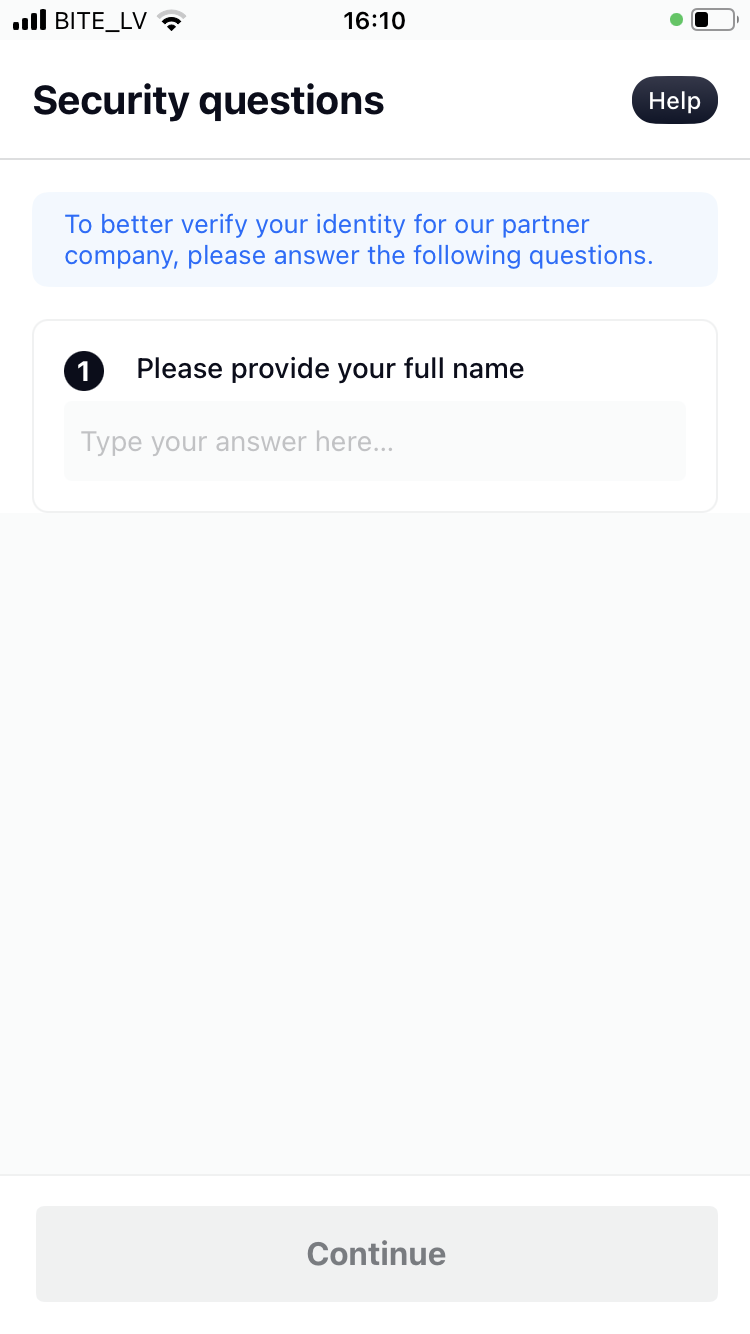
4.13. Wait about 1-5 minutes for your data to be processed.

4.14. Mark the checkboxes to agree to the terms of use, and press "I agree".
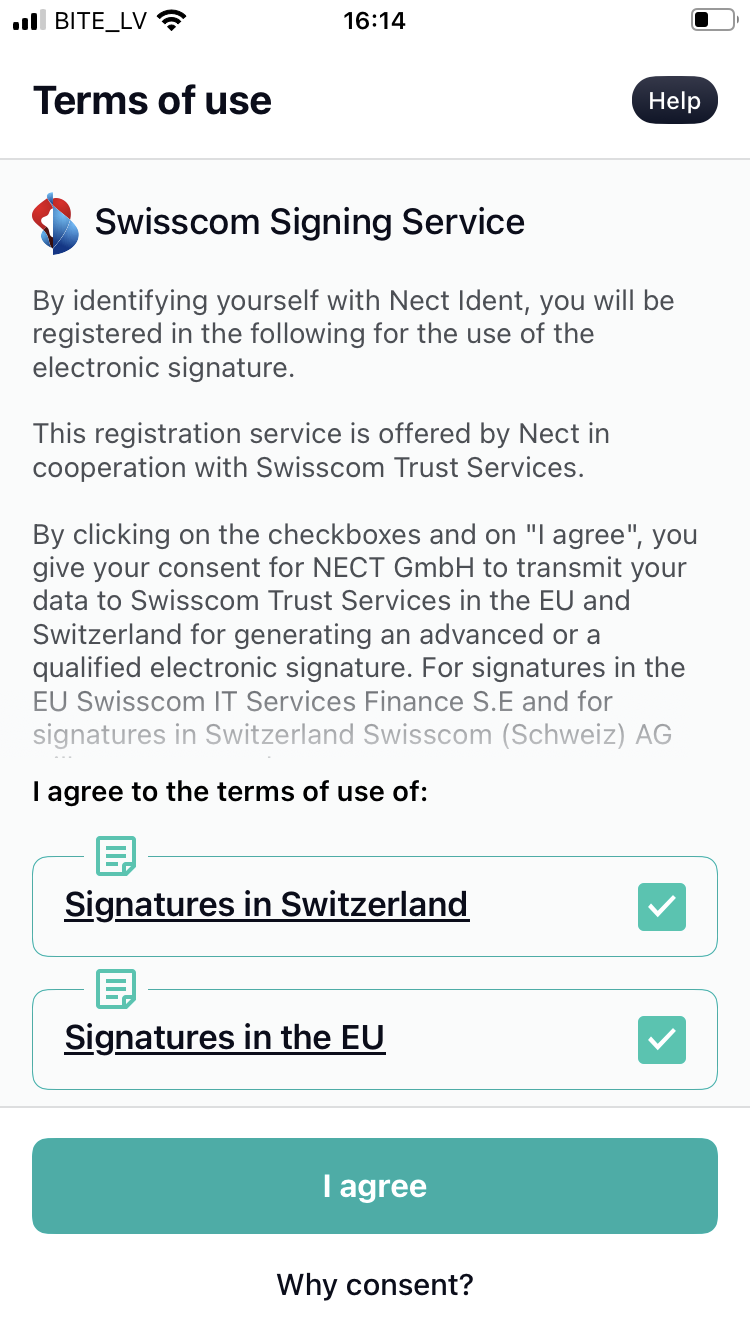
4.15. Enter your phone number in the provided field and press "Confirm phone number".

Wait for Swisscom to process your data, if necessary.

4.16. In the next step, the system will respond in one of two ways:
Option 1: If the system detects that your phone number is linked to an existing Mobile ID account, you will be asked to verify it in your app.

Option 2: If the system detects that your phone number isn't connected to an existing Mobile ID account, you will be required to set up a password.
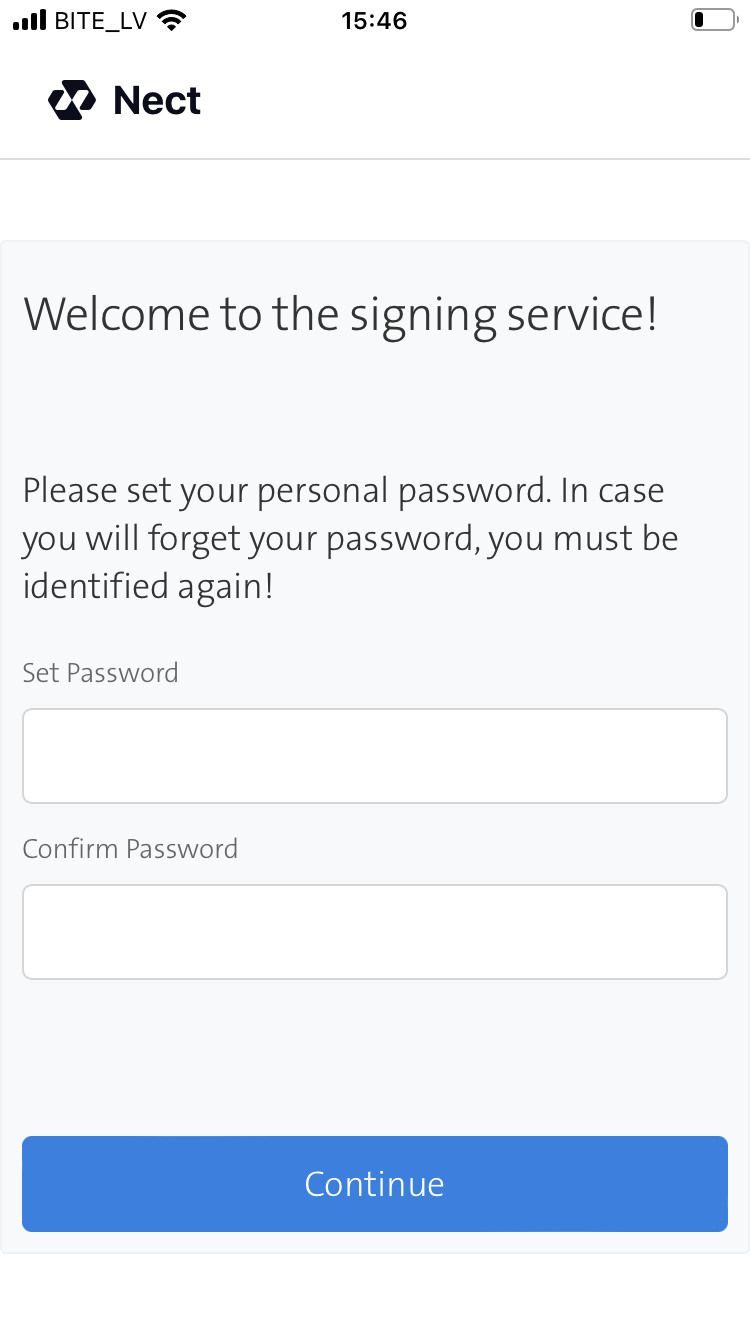
4.17. Once you've verified your phone number, you will have successfully verified your identity!
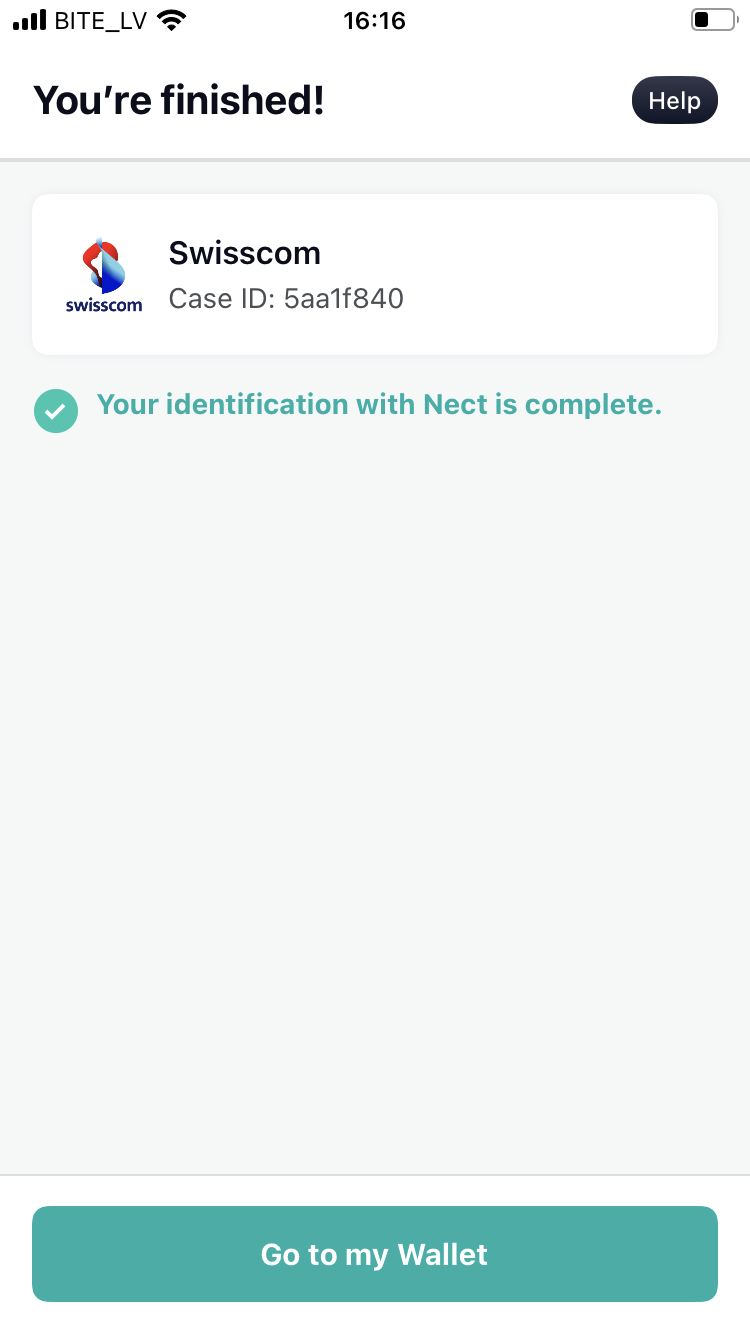
4.18. Now go back to the initial signing window and press "Continue" to continue signing the document.

Note: If the signing session has expired while you were going through the identity verification process, you may encounter an "Unknown error" message when you click "Continue." In this case, we suggest reopening the Dokobit signing window and starting the process anew. The system will recognize that your data is associated with a Swisscom account, allowing you to proceed with signing without the need for re-verification.
Unsure if the identity verification process was truly successful?
Double-check if you were registered in the Swisscom database → here.
Experiencing issues when attempting to verify your identity?
For frequently asked questions regarding the Nect Wallet app, please visit their support center → here.
Additional instructions: verifying your identity with video identification
Summary: Video identification allows you to verify your identity through a video call service by speaking with a live agent and following their instructions. For this method, you will need either a desktop computer with a built-in webcam and a reliable internet browser or a smartphone with the Identity.TM app. A valid ID will also need to be presented. You will be required to converse in English or German. For further instructions, follow the steps below. ↓
5.0. When choosing an identity verification method, pick "Video identification" and press "Continue".
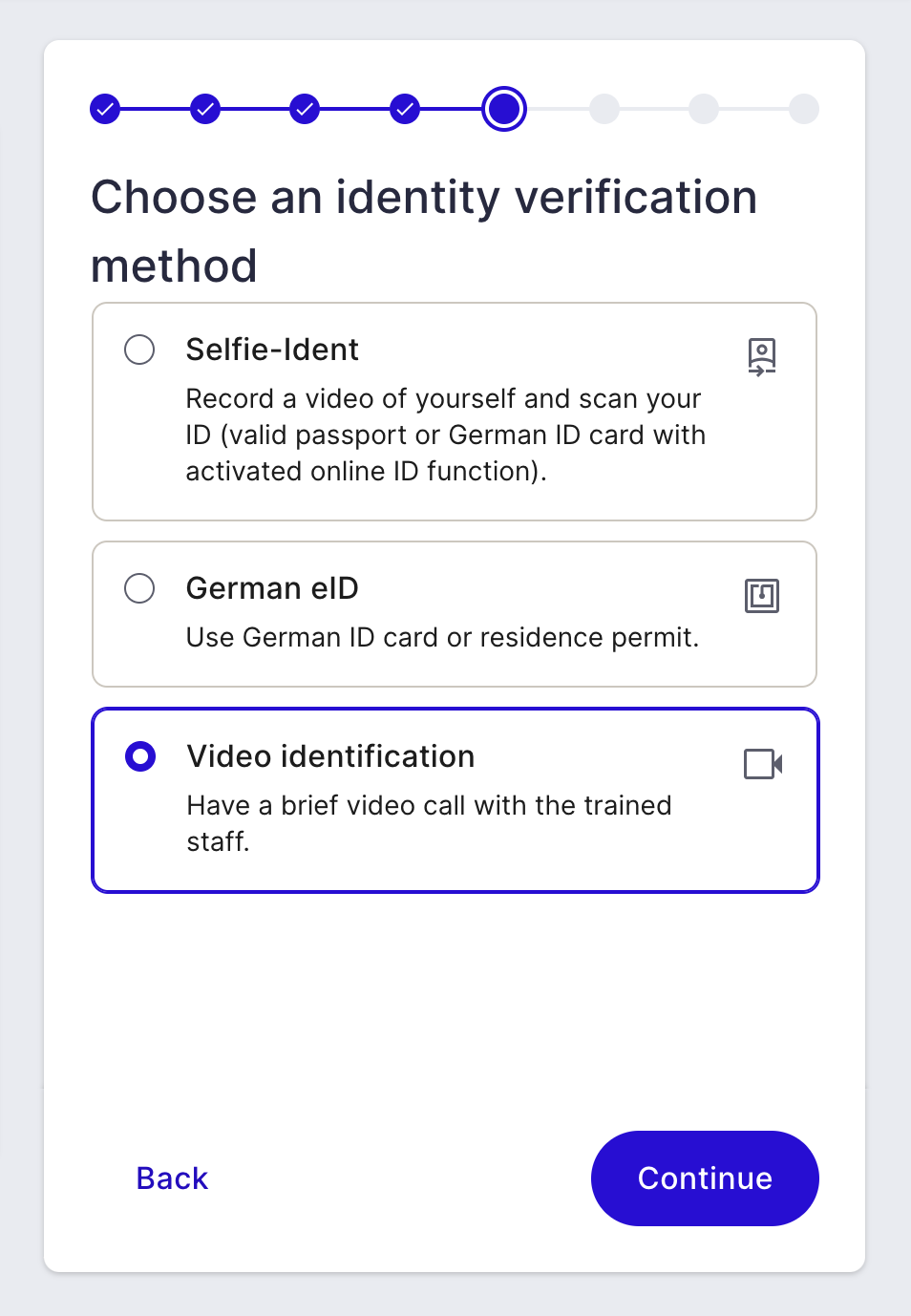
Familiarize yourself with the requirements of the process and press "Start".
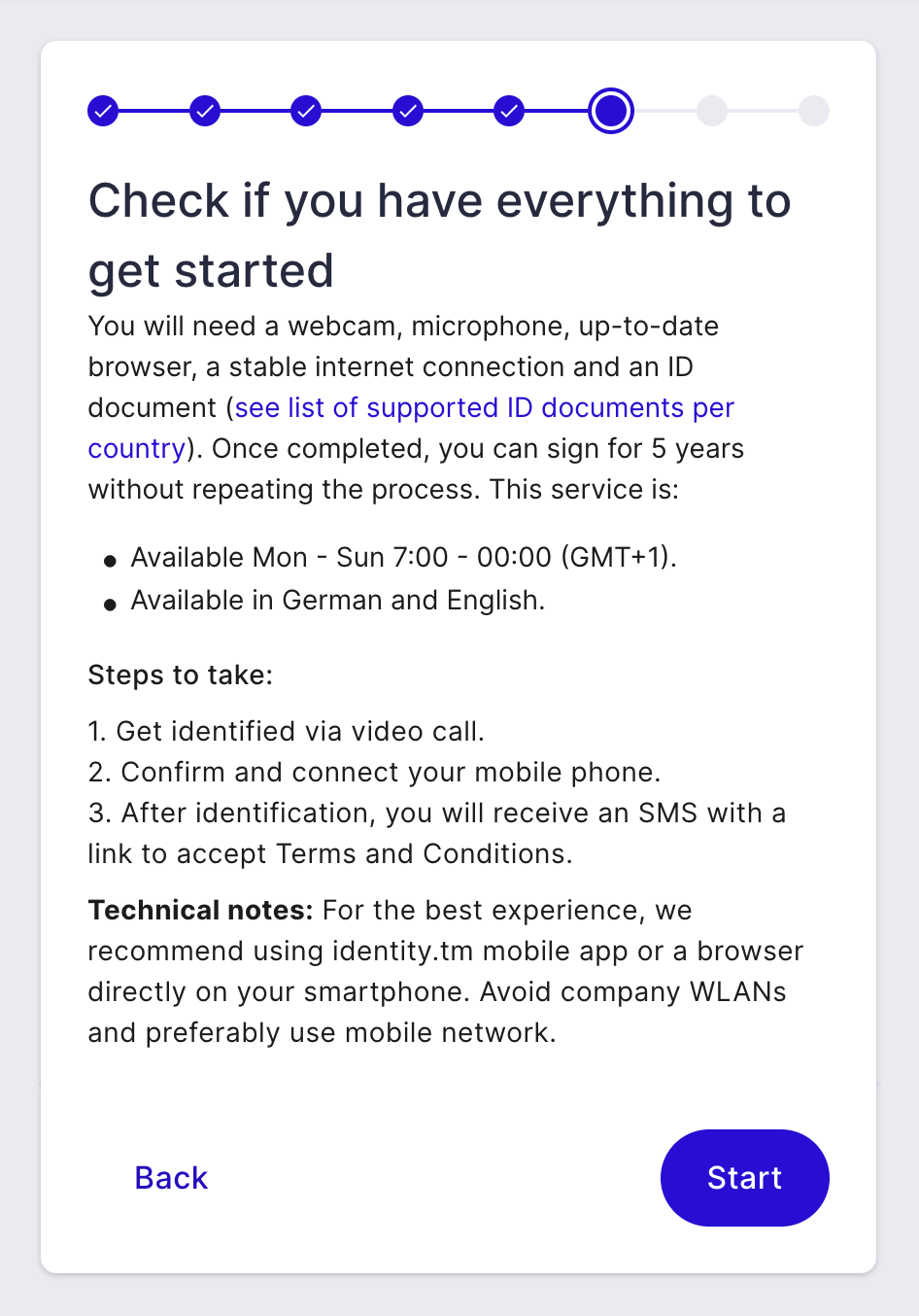
5.1. You will then be redirected to the identity.TM website. Here you will be given the choice between verifying your identity using your smartphone and the identity.TM app or your web browser.

If you'd like to carry out the process using your smartphone, in the first step, scan the QR code and follow the instructions as listed in the image example below.
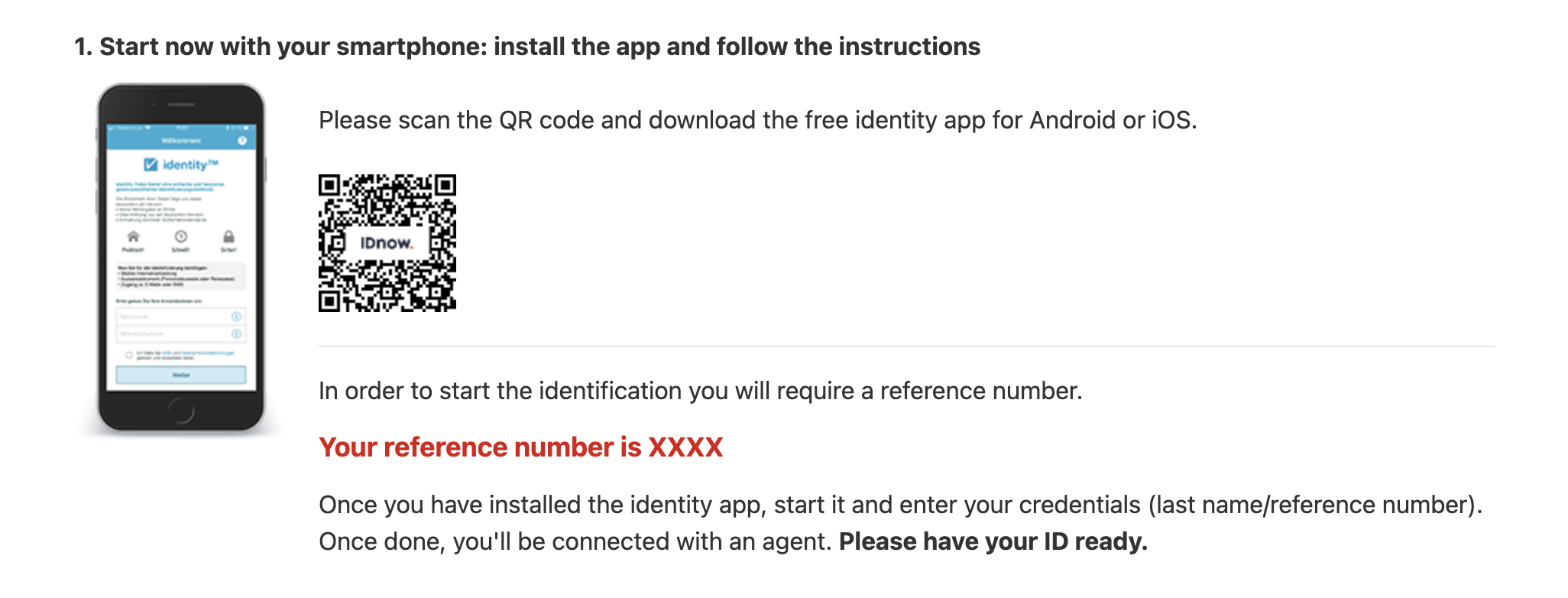
If you'd like to carry out the process using your web browser, accept their privacy policy and press "Start identification".
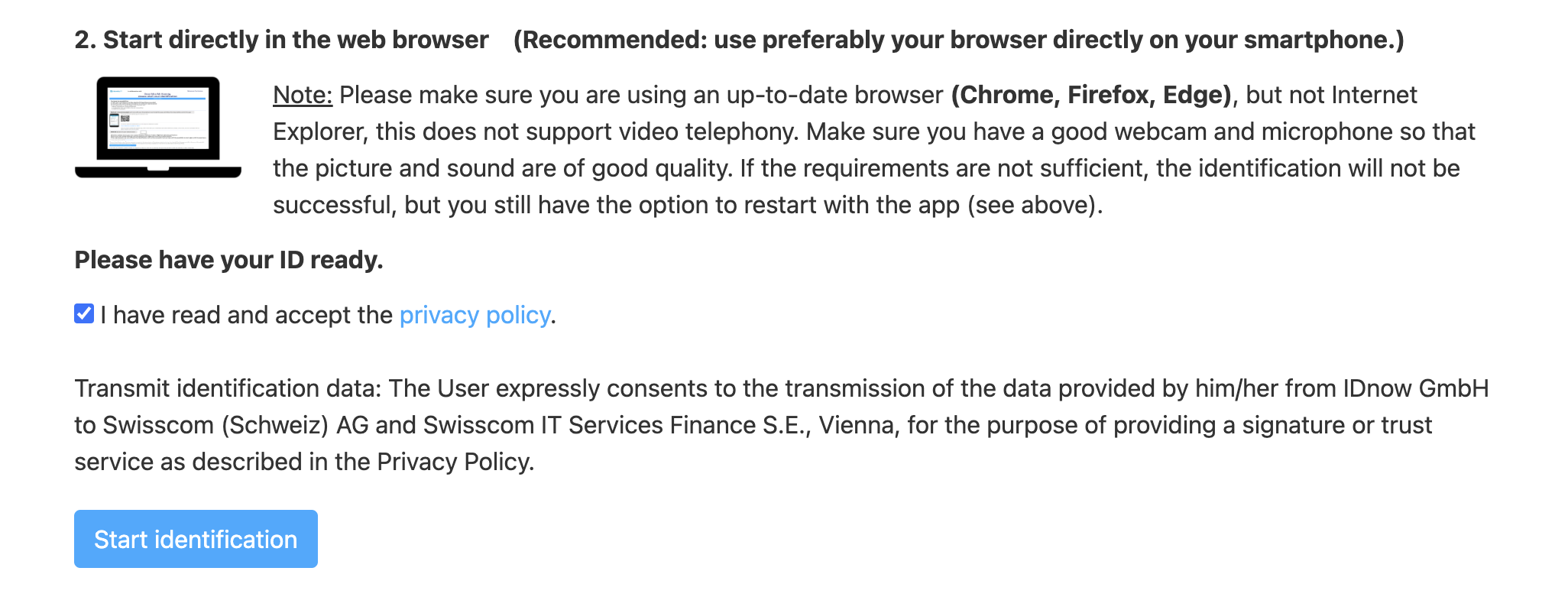
Note:For demonstration purposes, in the following steps of these instructions, we will be using the smartphone method. Even though the smartphone method requires downloading an additional app, please be aware that the basic steps for both methods are actually the same.
5.2. Once the app has been downloaded and opened, enter your last name and reference number, then tap "Start identification".
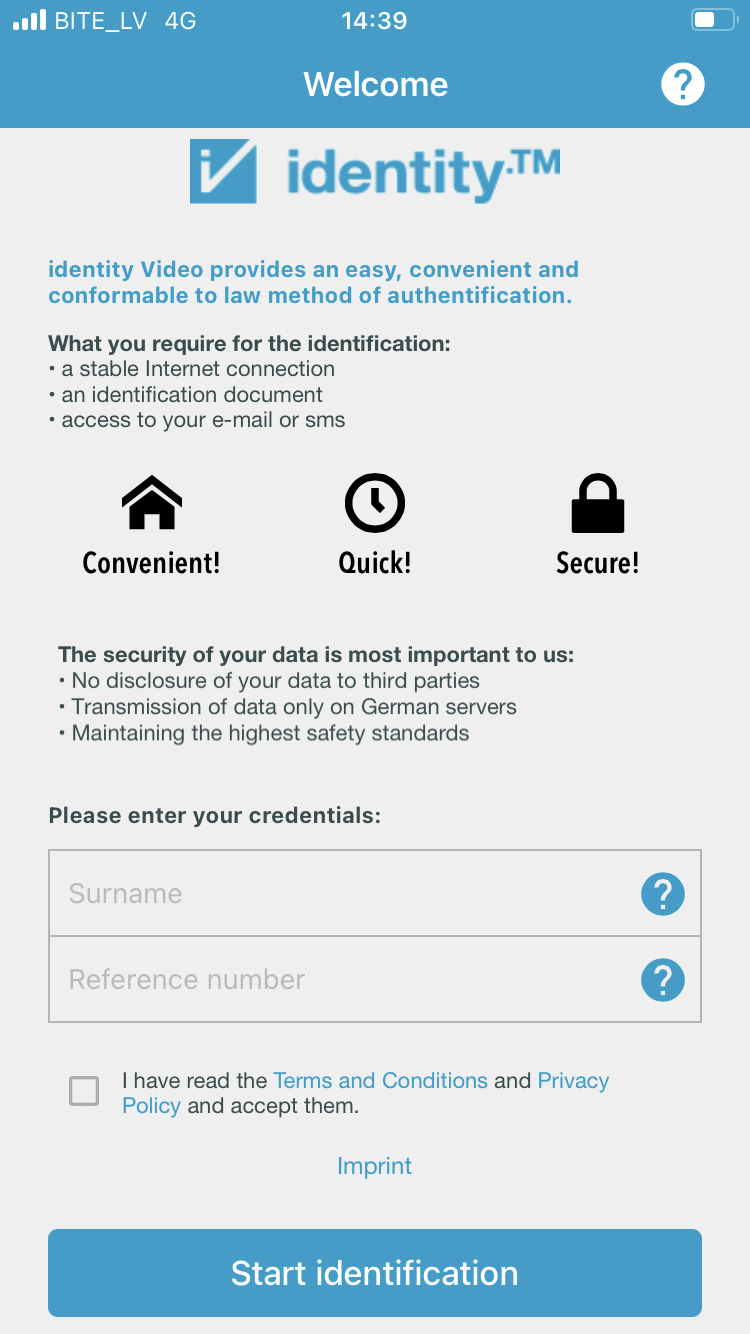
5.3. Then, select the ID you're going to use for identification.
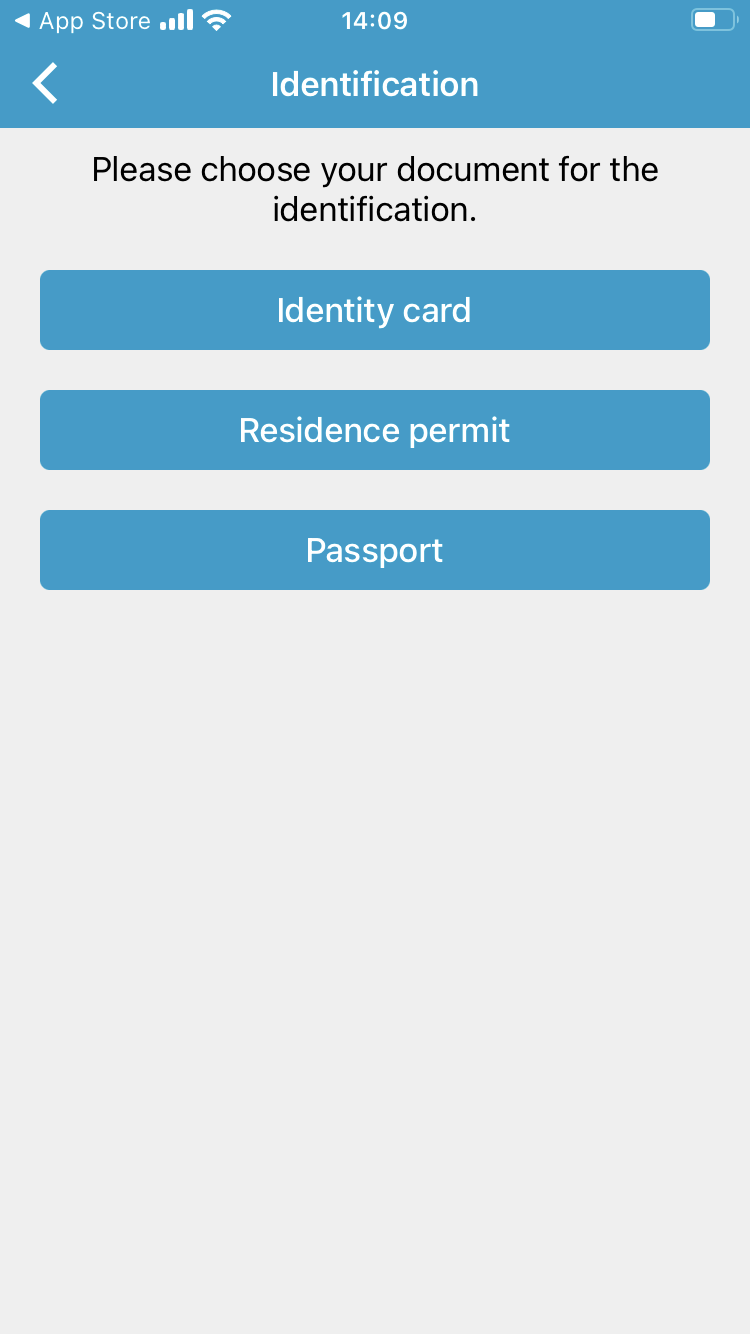
5.4. Grant the app permission to access your camera.
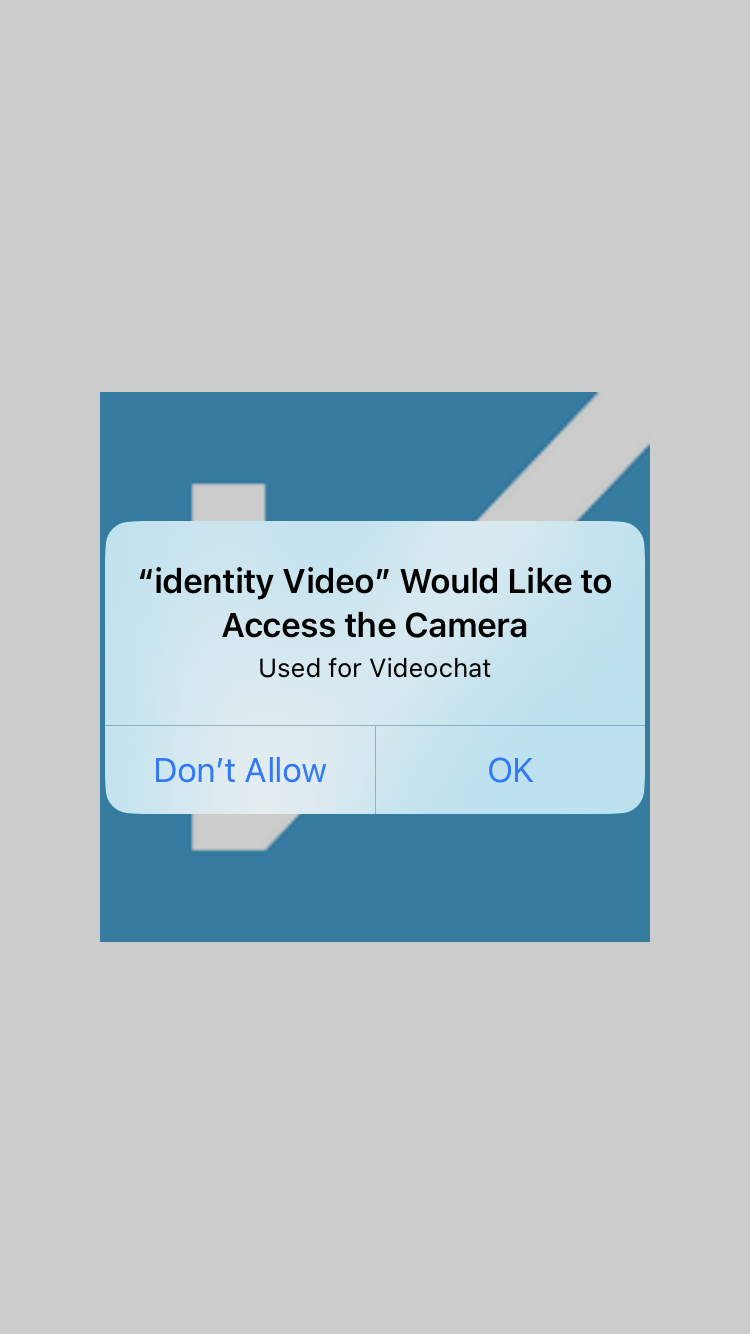
5.5. Scan the front of your document. For ID cards, you will also be required to scan the back of your document.
Note: For demonstration purposes, the camera screen has been blacked out in the following screenshot example.
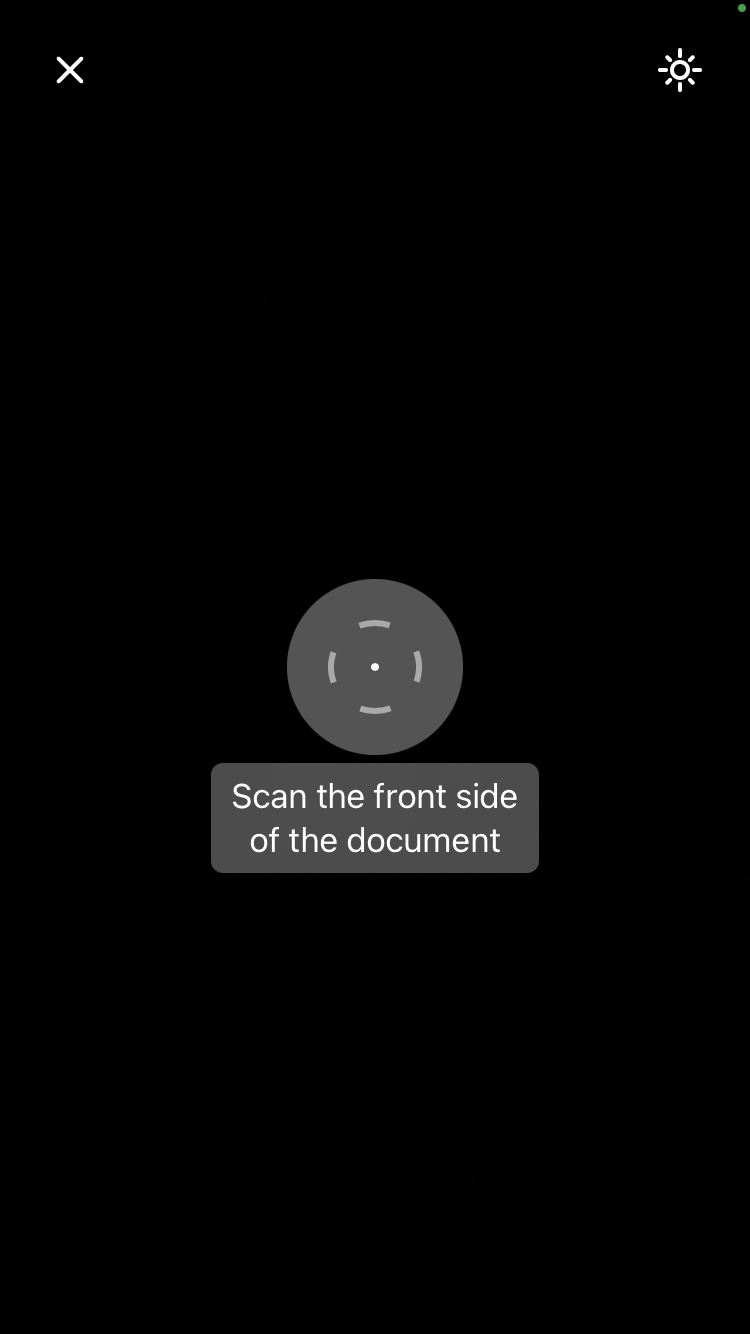
5.6. If the photos taken are clear enough, press "Send".
Note: For demonstration purposes, the camera screen has been blacked out in the following screenshot example.
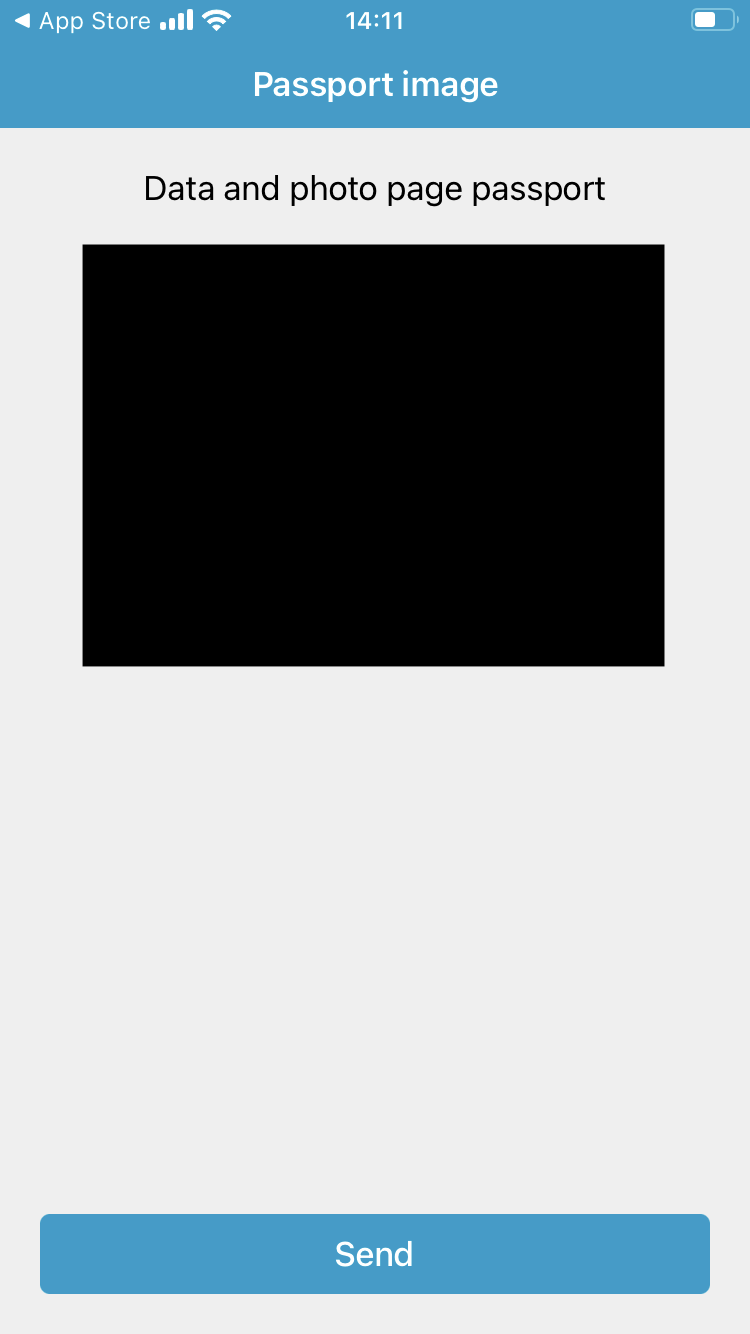
Then, wait for your pictures to be transmitted.

5.7. The identity.TM The app will need to test the strength of your internet connection to ensure successful video identification. To allow this, press "Continue".
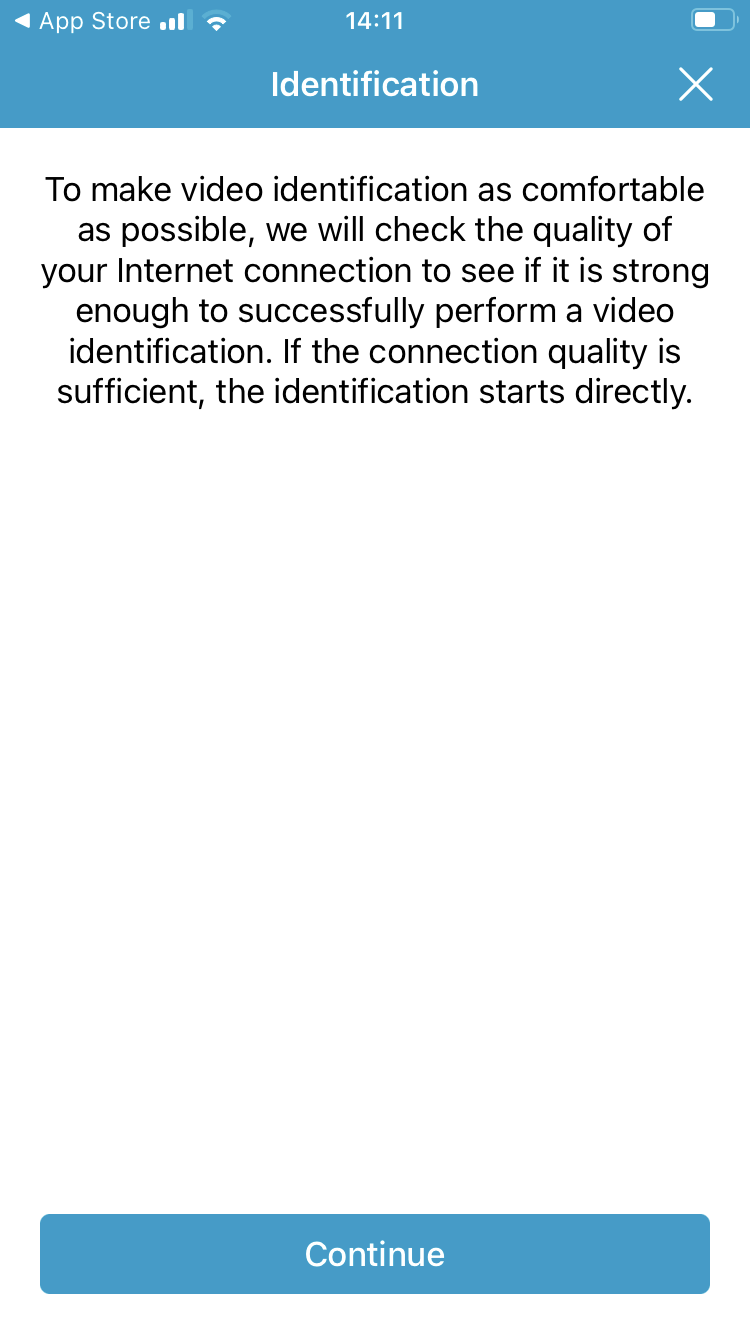
5.8. If the connection is strong enough, you will have to grant the app permission to access your microphone.
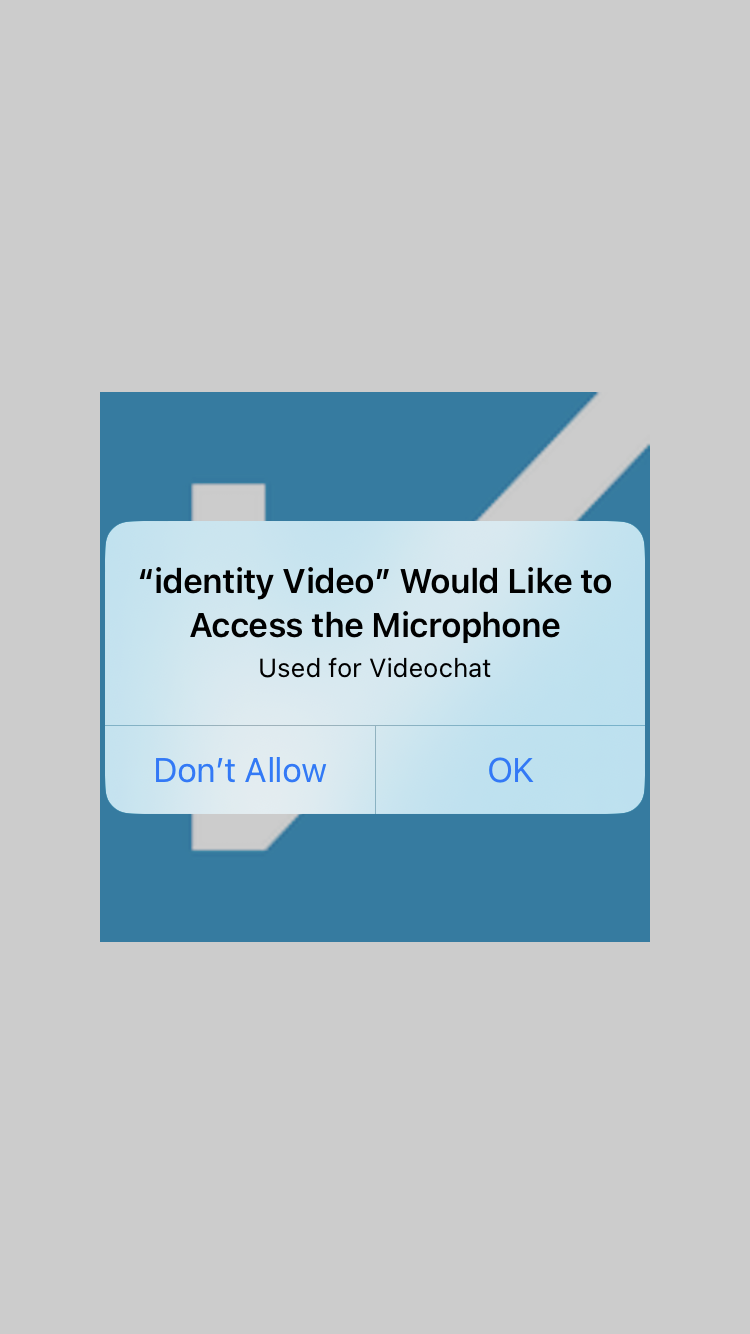
5.9. Wait for the video identification window to load.
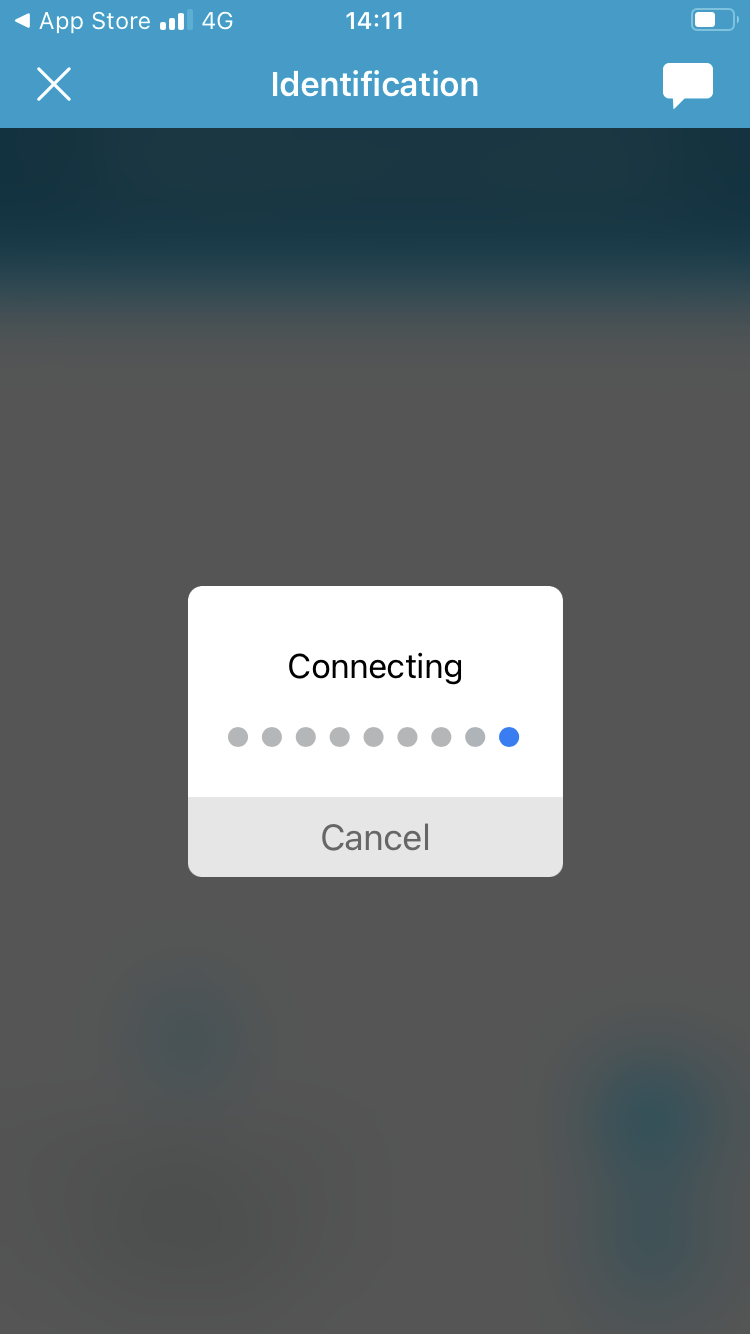
5.10. Here your front-facing camera will turn on, and you will have to wait to be connected to a live agent. Once they connect, follow the instructions given by the agent.
Note: For demonstration purposes, the camera screen has been blacked out in the following screenshot example.
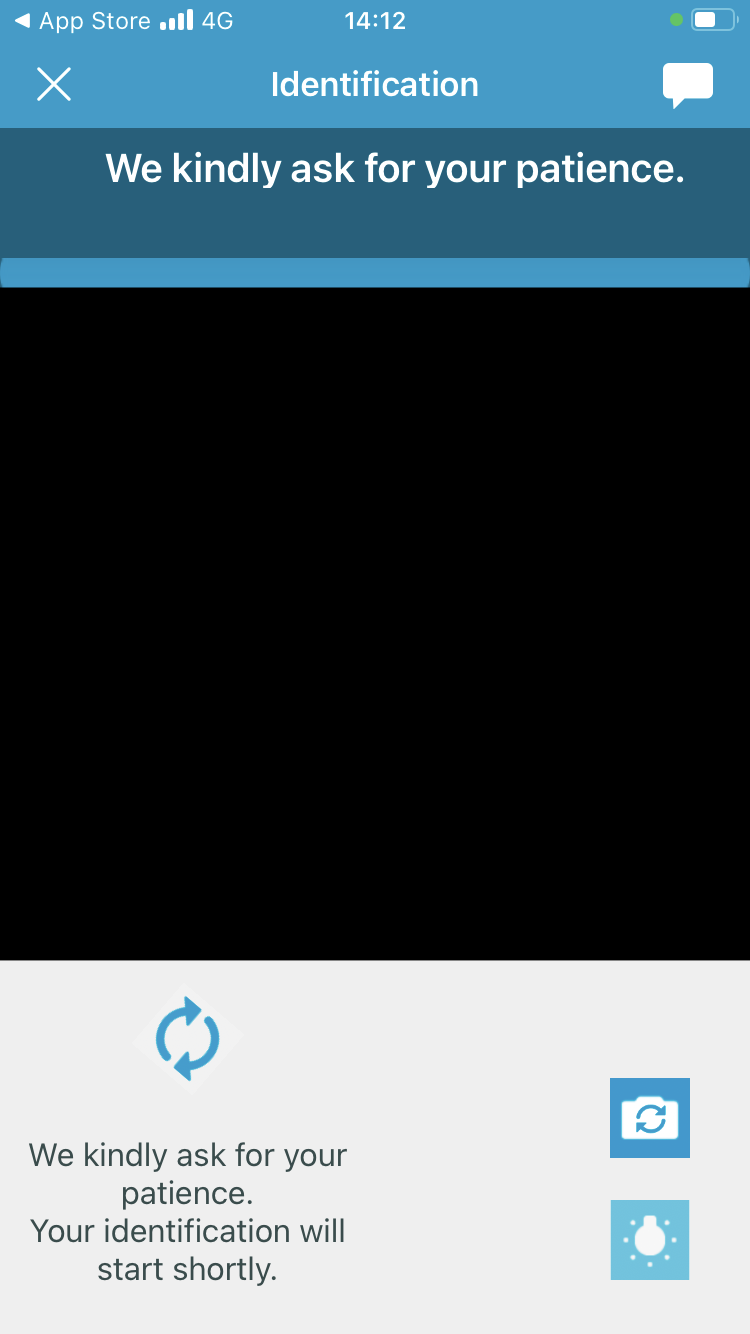
Near the end of the conversation with the live agent, you will be sent a link to your mobile phone where you will have to agree to the Terms and Conditions of Swisscom by either using your Mobile ID app or an OTP. If you don't have a Mobile ID account, you will also be asked to set up a password for signing documents.
5.11. Once the identification process is complete, return to the initial signing window and press "Continue" to proceed with signing the document.

Note: If the signing session has expired while you were going through the identity verification process, you may encounter an "Unknown error" message when you click "Continue." In this case, we suggest reopening the Dokobit signing window and starting the process anew. The system will recognize that your data is associated with a Swisscom account, allowing you to proceed with signing without the need for re-verification.
Unsure if the identity verification process was truly successful?
Double-check if you were registered in the Swisscom database → here.
Why we need you to electronically sign documents?
By law, to register a company, there are two ways to sign documents:
- Through handwritten, original documents being sent through the post. However, this often increases suspicion about people's identities due to a lack of a clear way to tie the founders to actual individuals.
We don't recommend this route, as registrars can request your physical presence by law to ensure no fake documents are used. - Through digital documents that are electronically signed.
- Electronically certified (as the original) using a QES signature, where the signator guarantees your personality and takes responsibility for the legality and truthfulness of the documents.
Registrators can still doubt your identity and ask for your physical presence. - Fully electronically signed (so submitting the original) using a QES signature, where all parties electronically sign. This distributes the responsibility to all signatories and is recommended to ensure clear validation of people's identities.
Registrators can still doubt your identity, but the fact that your identity is already certified allows our lawyers to then intervene to represent you, in order to remove the right of the registrators to request your physical presence.
- Electronically certified (as the original) using a QES signature, where the signator guarantees your personality and takes responsibility for the legality and truthfulness of the documents.
This ensures clear identification of all signators, and while it takes more time, ensures things go smoothly during registration, but also afterward.
Having registration 100% digitally opens the door to malicious individuals attempting to create ghost companies, and this procedure removes any attempt to use false identities, as they would be detected in the registration process.
Unfortunately, we have received requests in the past from malicious actors attempting to evade sanctions, and this requirement was implemented to counter such efforts.
Benefits of getting an electronically signed memorandum
With a qualified electronic signature (QES) issued, you gain several benefits when accessing other services in the future, such as:
- Accessing government grants: They require QES-signed documents, and now you have a QES signature issued.
- Bank Account Opening: Banks typically demand your physical presence for identification, but with QES, this responsibility is delegated to the trust provider, who can verify your identity remotely. There's no longer a need to travel to Romania for two weeks just to open a basic bank account.